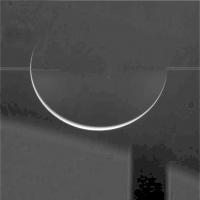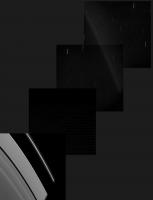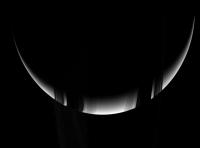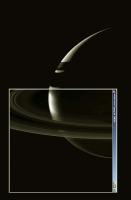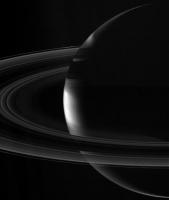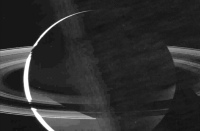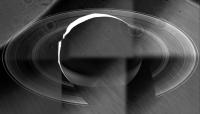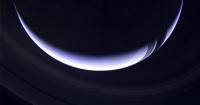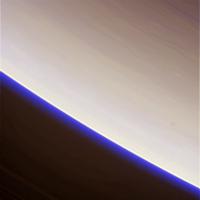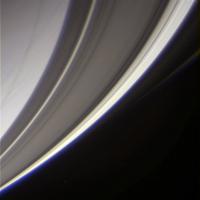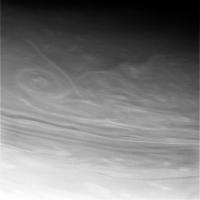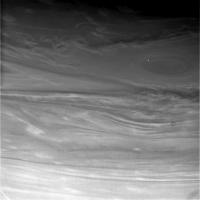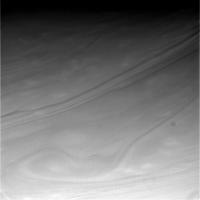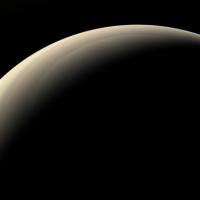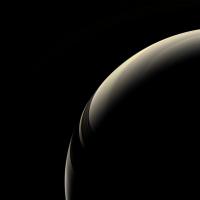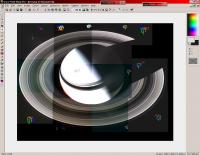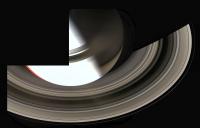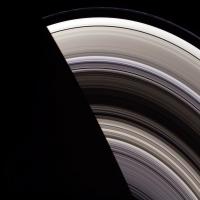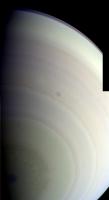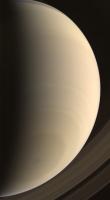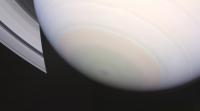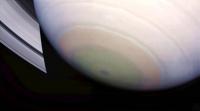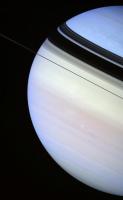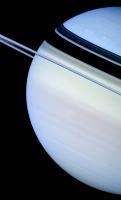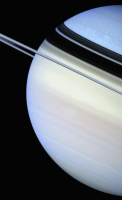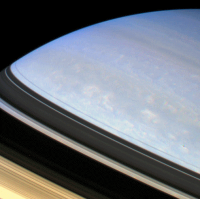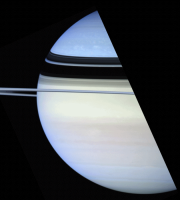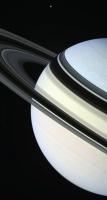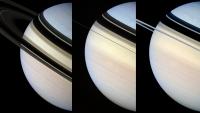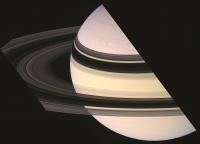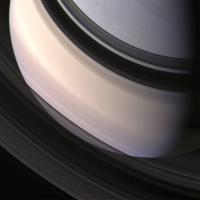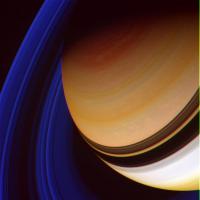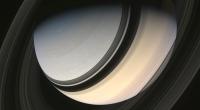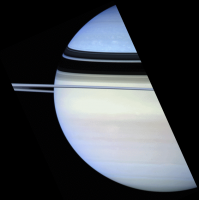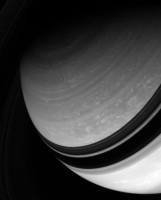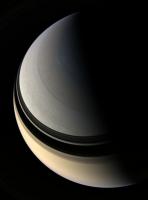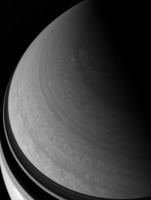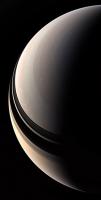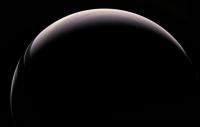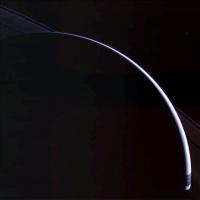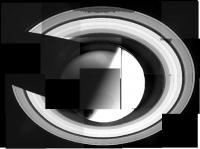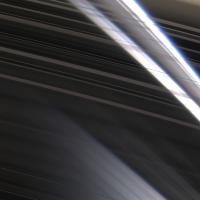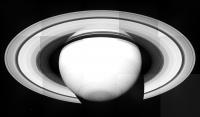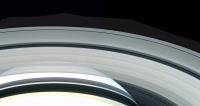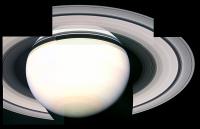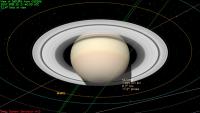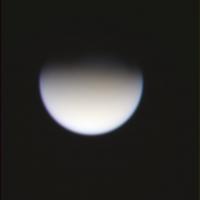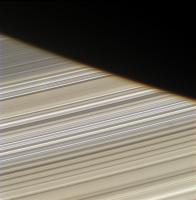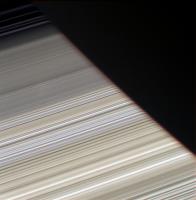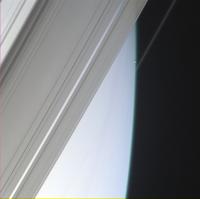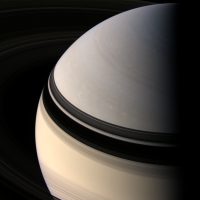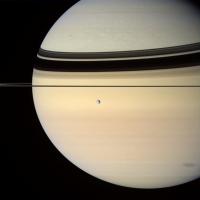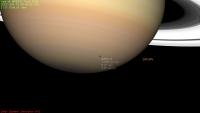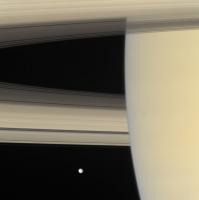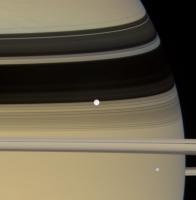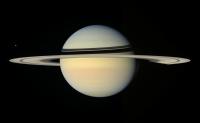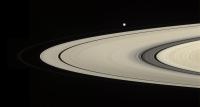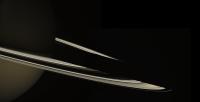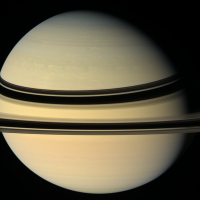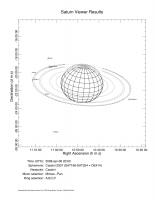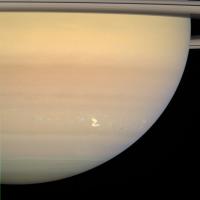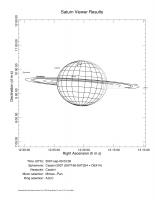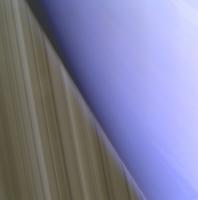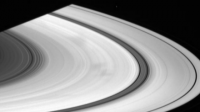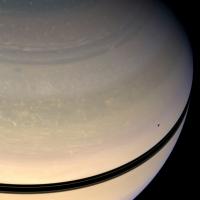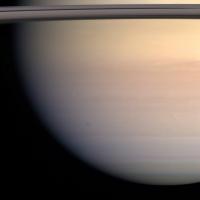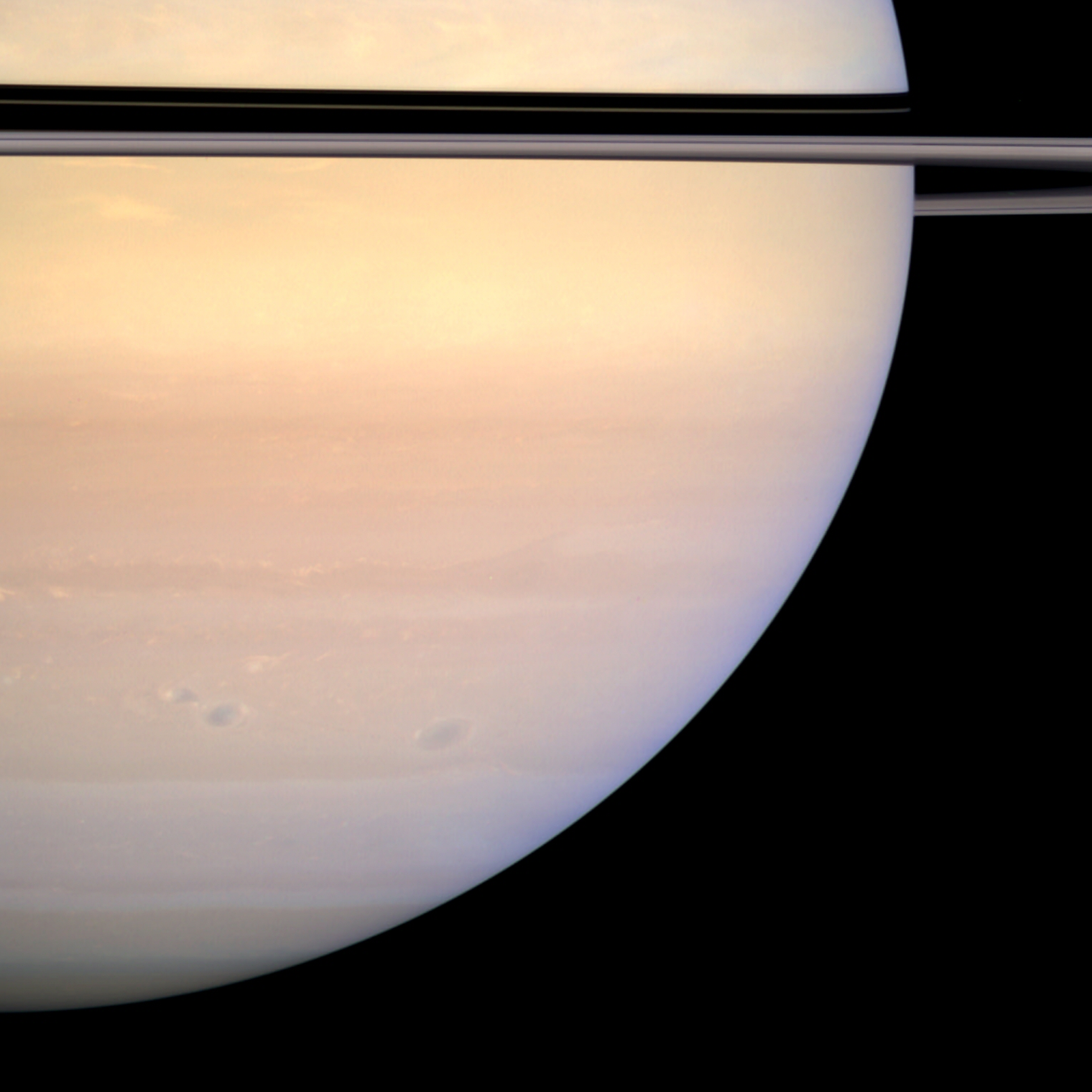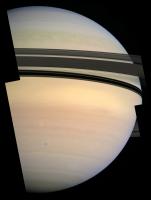Printable Version of Topic
Click here to view this topic in its original format
Unmanned Spaceflight.com _ Cassini's ongoing mission and raw images _ Exquisite Saturn Images
Posted by: paxdan Jul 12 2006, 09:37 AM
There are some http://saturn.jpl.nasa.gov/multimedia/images/raw/casJPGFullS21/W00016082.jpg images coming down in the raws at the moment.
You can really see how oblate saturn is.
Posted by: nprev Jul 12 2006, 03:12 PM
Yep...some lucky tourists will pay the big bucks to see that in person around the year 2300 or so... ![]()
Posted by: bdunford Jul 12 2006, 06:32 PM
The oblation is what struck me, too.
What are we seeing in the images that alternate with with crescent shots? I assume it's the cloud tops, and the black band at the bottom is the shadow of the rings or the rings themselves.
Posted by: bdunford Jul 12 2006, 06:39 PM
Definitely.
Meanwhile, we'll have to be grateful for whoever at JPL takes the trouble to post the feeds.
Posted by: jsheff Jul 12 2006, 07:00 PM
Yes, whoever does that is an unsung hero.
Notice the tiny black dot in the upper left of the crescent? In a similar image released last week
http://ciclops.org/view.php?id=2062&flash=1 such a dot was identified as Epimetheus. I wonder if that's what it is here or perhaps another satellite?
Posted by: ljk4-1 Jul 12 2006, 09:38 PM
What is that little white dot at the bottom of the image?
Posted by: ugordan Jul 13 2006, 06:41 AM
If you turn the brightness up you can see that it's actually the rings intersecting the disc, not a moon.
EDIT: A shot that does show a moon, Titan alonside Saturn's right limb.
http://saturn.jpl.nasa.gov/multimedia/images/raw/raw-images-details.cfm?feiImageID=79245
The bottom of the image was unfortunately clipped off on the spacecraft during readout.
Posted by: MizarKey Jul 24 2006, 08:03 PM
You can really see how oblate saturn is.
Exquisite image.
It's interesting though how much 'noise' there is in the image, it appears they have barely 50% of the frame to work with...see attached image of W00016082 with the gamma correction turned way up. Do they use a mask of some sort to clean the lens smears and such?
Posted by: JRehling Jul 24 2006, 08:06 PM
The TV camera adds ten Earth masses to your waistline.
Posted by: paxdan Jul 27 2006, 08:36 AM
http://saturn.jpl.nasa.gov/multimedia/images/raw/raw-images-details.cfm?feiImageID=80376
can someone please stitch these so we can have the entire crescent
Posted by: paxdan Jul 27 2006, 09:46 AM
Thanks Doug, is that the e-ring showing up in the first?
Umm, i think something might have gone a little wrong with the second. i was thinking more like stiching http://saturn.jpl.nasa.gov/multimedia/images/raw/raw-images-details.cfm?feiImageID=80381 and http://saturn.jpl.nasa.gov/multimedia/images/raw/raw-images-details.cfm?feiImageID=80377 image.
Posted by: djellison Jul 27 2006, 09:52 AM
That would be a blue image on the left and a methane band ( I think ) filter on the right. I did try the methane band images, but they have been 2x2 downsampled ![]()
Doug
Posted by: djellison Jul 27 2006, 10:06 AM
Ah - you mean like this.
Pity the more exotic filters are down-sampled - but hey - we get what we get ![]()
Doug
Posted by: paxdan Jul 27 2006, 10:38 AM
Yup, spectacular.
Posted by: ynyralmaen Jul 27 2006, 12:32 PM
I think it's the G-ring.
Posted by: Ian R Aug 2 2006, 10:04 AM
Here's the best I could do with the latest set of raws images from Cassini:
Ian.
Posted by: dilo Aug 2 2006, 11:53 AM
Below my personal attempt to process the two wide-angle crescent images W00016128 and W00016686 (for the last one, in reality, i used RGB images W00016687/8/9 and I made also an enhanced color version):
Posted by: Jyril Aug 2 2006, 08:27 PM
Wonderful! Looks like a bad b&w scan of a Chesley Bonestell painting.
Posted by: paxdan Aug 14 2006, 02:15 PM
http://saturn.jpl.nasa.gov/multimedia/images/image-details.cfm?imageID=2231
Posted by: David Aug 14 2006, 05:24 PM
Bonestell's paintings are more real than reality, aren't they?
Posted by: ugordan Aug 16 2006, 04:17 PM
A dirty wide angle RGB mosaic from near the ring plane (groan, again!) with a moon I can't quite identify. Might be Rhea judging by the size, I dunno.
Posted by: volcanopele Aug 16 2006, 07:57 PM
Nice mosaic!
Even though we are in a more inclined orbit, we do cross the ring plane twice an orbit ![]()
Posted by: remcook Aug 17 2006, 08:46 AM
there were some nice ring images taken last time I checked the raw images...
edit - some actual links:
http://saturn.jpl.nasa.gov/multimedia/images/raw/raw-images-details.cfm?feiImageID=80681
http://saturn.jpl.nasa.gov/multimedia/images/raw/raw-images-details.cfm?feiImageID=80448
http://saturn.jpl.nasa.gov/multimedia/images/raw/raw-images-details.cfm?feiImageID=80417
http://saturn.jpl.nasa.gov/multimedia/images/raw/raw-images-details.cfm?feiImageID=80425
also nice (there are multiple filters of these it seems! looking forward to seeing this in colour - wink wink nodge nodge ;-) ):
http://saturn.jpl.nasa.gov/multimedia/images/raw/raw-images-details.cfm?feiImageID=80722
Posted by: ugordan Aug 20 2006, 11:36 AM
Yet another crescent pic; after periapsis and this time with the rings:
Posted by: Ian R Oct 6 2006, 03:24 AM
Here's the latest six-frame mosaic:
It really is a pity that the WAC doesn't seem to have an adequate enough sun shield.
Posted by: dilo Oct 6 2006, 06:23 AM
Beautiful images, Ian! ![]()
Posted by: ugordan Oct 13 2006, 07:40 AM
Not exactly crescent images, but these raws are just... wow!
South pole vortex, appears oval:
http://saturn.jpl.nasa.gov/multimedia/images/raw/raw-images-details.cfm?feiImageID=85891
http://saturn.jpl.nasa.gov/multimedia/images/raw/raw-images-details.cfm?feiImageID=85879
http://saturn.jpl.nasa.gov/multimedia/images/raw/raw-images-details.cfm?feiImageID=85875
http://saturn.jpl.nasa.gov/multimedia/images/raw/raw-images-details.cfm?feiImageID=85874
http://saturn.jpl.nasa.gov/multimedia/images/raw/raw-images-details.cfm?feiImageID=85872
Posted by: dilo Oct 24 2006, 07:46 PM
...and now look at this:
http://saturn.jpl.nasa.gov/multimedia/images/raw/casJPGFullS24/W00019111.jpg
A true example of Cassini modern art...! ![]()
Posted by: ElkGroveDan Oct 24 2006, 07:58 PM
http://saturn.jpl.nasa.gov/multimedia/images/raw/casJPGFullS24/W00019111.jpg
A true example of Cassini modern art...!
Posted by: volcanopele Oct 24 2006, 08:05 PM
Saturn images are not my responsibility. I take no responsibility for any problems (or fantastic backlit mosaics) that might be associated with Saturn.
Posted by: Borek Oct 24 2006, 09:05 PM
http://saturn.jpl.nasa.gov/multimedia/images/raw/casJPGFullS24/W00019111.jpg
A true example of Cassini modern art...!
Oh gosh! There's more cruft in the optics than I thought.
Posted by: mchan Oct 25 2006, 05:56 AM
http://saturn.jpl.nasa.gov/multimedia/images/raw/raw-images-details.cfm?feiImageID=85891
http://saturn.jpl.nasa.gov/multimedia/images/raw/raw-images-details.cfm?feiImageID=85879
http://saturn.jpl.nasa.gov/multimedia/images/raw/raw-images-details.cfm?feiImageID=85875
http://saturn.jpl.nasa.gov/multimedia/images/raw/raw-images-details.cfm?feiImageID=85874
http://saturn.jpl.nasa.gov/multimedia/images/raw/raw-images-details.cfm?feiImageID=85872
Aiiieee!!! The Shoggoths!!!
Posted by: dilo Oct 31 2006, 06:10 AM
New amazing Saturn/rings pictures obtained on Oct,30 with Blu and Violet filters...
Here an examples from wide cam:
Narrow cam details:
and atmosphere 3D structures with enhanced local contrast (CB3 filter):
Posted by: ugordan Oct 31 2006, 06:03 PM
Check out the terminator region on top of this image:
http://saturn.jpl.nasa.gov/multimedia/images/raw/raw-images-details.cfm?feiImageID=87366
Posted by: dilo Oct 31 2006, 08:33 PM
Good catch, ugordan!
Here below enhanced version, toghether to another nice shot (N068709):
Posted by: David Nov 1 2006, 01:16 AM
Here below enhanced version, toghether to another nice shot (N068709):
Are my eyes playing tricks on me, or do some of those clouds have discernible shadows, suggesting that they're projecting a considerable height above a lower cloud layer?
Posted by: dilo Nov 1 2006, 07:26 AM
Absolutely yes, David.
Look to this old http://saturn.jpl.nasa.gov/multimedia/images/image-details.cfm?imageID=1407 and see also http://www.unmannedspaceflight.com/index.php?s=&showtopic=704&view=findpost&p=5629 on the argument.
Posted by: ugordan Nov 5 2006, 11:22 AM
Yet Another Crescent Image:
Wide-angle camera RGB composite, W00019472-W00019474
Posted by: JRehling Nov 5 2006, 11:33 AM
Saturn has a very "deep" atmosphere. The cloud-level gravity is actually only slightly greater than Earth's, and at cloud depths, the temperature is comparable to that of Earth's cloud levels. But Saturn has the lowest molecular weight atmosphere of any in the solar system -- almost pure H2. Simply put, that gives Saturn about 7 times the scale height of Earth, so cloud phenomena get some tremendous vertical stretching.
Posted by: ugordan Nov 12 2006, 12:13 PM
A rather colorful north polar area on Saturn is revealed in these WAC RGB composites. The unlit rings are too dim to be visible here without severe compression artifacts.
Posted by: dilo Nov 12 2006, 07:28 PM
My compsitions...
Posted by: dilo Dec 10 2006, 09:19 AM
A manual stitch from some clear filter images taken on Dec,06 (original picures W00020421/26/34/32):
Colorization is, in reality, a sort of false color coding from original B/W.
(There are also nice G-ring http://saturn.jpl.nasa.gov/multimedia/images/raw/raw-images-details.cfm?feiImageID=92276)
Posted by: elakdawalla Jan 21 2007, 05:14 AM
Yay! That's the Saturn shot I've been waiting for since I saw the plans for the tour and noticed the high inclination orbits. Too bad the raws are so saturated -- hope the actual data shows more subtlety in Saturn's disk.
--Emily
Posted by: Ian R Jan 21 2007, 09:56 AM
Emily - there's quite a bit of detail in the region of Saturn's terminator, especially near the North pole where there are several bands and lots of clouds visible.
So far so good...
Posted by: Airbag Jan 21 2007, 06:04 PM
I quite like this RGB composite of recent images:
Airbag
[edited: D'oh - I see now that this is just one of the images that make up the larger images above]
Posted by: Ian R Jan 25 2007, 11:03 AM
After hours of hard work (don't forget that this is my first ever attempt at producing a colour mosaic on this kind of scale), here is Saturn in all its glory!
http://img442.imageshack.us/my.php?image=saturn2007ianregan6jl.jpg
There are still a few tweaks to be made, of course, and I hope to post the final version at the weekend.
Enjoy! ![]()
![]()
Ian.
Posted by: tedstryk Jan 25 2007, 11:08 AM
Wow! Extremely impressive work!
Posted by: Bjorn Jonsson Jan 25 2007, 11:18 AM
Looks great! One 'error' I noticed though is that the rings are brighter at upper right than in the lower left half of the image. The rings should be noticeably brighter in the lower left half than elsewhere due to Saturnshine - maybe one of the tweaks left to do.
Posted by: jamescanvin Jan 25 2007, 11:21 AM
That is totally awesome! Great work, hard to believe that's your first!
I wish I had time to play with Cassini images, but I see there is no need anyway with all the great stuff being done by you lot ![]()
James
Posted by: ugordan Jan 25 2007, 11:25 AM
Awesome! I didn't think the footprints would align well but you made it look seamless! Great work!
Posted by: remcook Jan 25 2007, 11:41 AM
cool!
in the top right, are those moving moonlets (a similar effect as the dust devils by Mars Express)?
Posted by: ugordan Jan 25 2007, 11:45 AM
Yep, looks like Prometheus and Pandora and either Janus or Epimetheus.
Posted by: dilo Jan 25 2007, 08:08 PM
Bravissimo! ![]()
Posted by: dvandorn Jan 25 2007, 09:12 PM
Too bad all I get is an Imageshack page with a link to host my own pictures, but no image... ![]()
-the other Doug
Posted by: bdunford Jan 27 2007, 01:08 AM
With his permission, I've featured Ian's work on the http://www.ridingwithrobots.org site.
Posted by: Nix Jan 27 2007, 07:53 AM
BRAVO Ian, on a magical job, it's a very inspiring view you provided ![]()
Nico
Posted by: mars loon Jan 28 2007, 03:17 AM
Ian, absolutely glorious !!!!
I'd like to use this for my Cassini talk at a Planetarium in 2 weeks (with credit to you, NASA etc), assuming thats OK.
Cant wait to see your latest and greatest ![]()
ken
Posted by: ugordan Feb 1 2007, 12:36 PM
Apparently, the raws page houses at least two nice global views from above. One is the one Emily mentioned in her blog and Ian superbly mosaicked, and the other is a higher phase view and looking down from a higher inclination. I ran across it on an http://www.strudel.org.uk/blog/astro/000587.shtml, the author still seems to be working on it, but it promises to look equally impressive.
I can't wait till this stuff hits the PDS.
Posted by: mars loon Feb 1 2007, 07:18 PM
Ian's latest version is now on Emily's blog
http://www.planetary.org/blog/article/00000847/
Posted by: Ian R Feb 1 2007, 10:28 PM
I'd like to thank both Emily and Bill for kindly displaying the Saturn mosaic on the Planetary Society blog and the Riding With Robots website. It certainly makes all of the hours invested in the creation of the image worthwhile! ![]()
The wonderful repsonse from the UMSF stalwarts here is also greatly appreciated, and hopefully I will get around to implementing the suggestion that Bjorn made sometime soon. I am only an amateur at this game, with a minimal amount of knowlegde in the image processing field, so I welcome all constructive critiscism from the resident gurus and experts here.
I did see the second mosaic in the Cassini raw directory, but decided against putting that version together since I was so burnt-out from doing the first one. I'm pleased to see that someone else is putting the necessary time and effort needed to make sure that this Saturn portrait gets properly reproduced too.
Finally, Ken, of course you are welcome to use the composite in your lecture - thank you for being such a gentleman to ask permission in the first place. In general, I don't mind at all if people use my work without seeking my approval, but to go that one extra step is certainly a sign of pure class.
Good luck with the lecture! ![]()
Ian.
Posted by: Ian R Feb 1 2007, 11:36 PM
Here's a very quick-and-rough colour composite using some of the latest raw Cassini imagery:
Ian.
Posted by: dilo Feb 2 2007, 06:32 AM
Great work Ian, one more time! ![]()
Posted by: stevesliva Feb 2 2007, 07:32 PM
Wow, lots of weather going on there... vortices large and small. Very neat.
Posted by: Stu Feb 2 2007, 08:07 PM
Stunning work Ian, many congratulations! ![]()
Like Ken I'd like to ask your permission to show your image to others. I'm giving talks in 4 different junior schools next week, and also speaking to two community groups, and I'd love to show them your pic. Is that ok?
Posted by: Ian R Feb 3 2007, 12:06 AM
Yes, of course Stu - go for it! ![]()
Posted by: elakdawalla Feb 3 2007, 01:58 AM
I downloaded the frames for those in case I found the time to try to put them together -- but you beat me to it -- and did a much nicer job than I would have managed to! Keep it up!
Emily
Posted by: Ian R Feb 3 2007, 06:29 PM
Thanks Emily. I sure the colour balance isn't correct, and that Bjorn or ugordon could do a better job in that respect, but despite that, I'm quite pleased with the results so far. ![]()
My latest composite is a natural colour view of the south pole:
Cheers!
Ian.
Posted by: dilo Feb 3 2007, 07:22 PM
Poetry in space.... ![]() Ian, Bravo again!
Ian, Bravo again!
Edit: removed the quoted section and added a enhanced version (not realistic, only in order to highlight atmospheric features and chromatic differences):
Posted by: nprev Feb 3 2007, 07:35 PM
Ian, these are just stunning, really...incredible. It's the next best thing to being there, which probably none of us will ever get to do, so thank you very much! ![]()
Posted by: Ian R Feb 4 2007, 09:27 PM
Thanks nprev - I'm really flattered by your very kind words! I'm having a great deal of fun with the Cassini imagery at the moment, as you can no doubt see.
Ever since I first discovered this website, I have wondered and marvelled at the fantastic work done by the other members here - it's amazing to see so much talent in a single forum. It's very rewarding for me to finally be able to give a little bit back to the community that has provided me with so many truly great images over the past 18 months or so.
Posted by: Ian R Feb 5 2007, 01:34 AM
Here's a short GIF animation showing Cassini approaching the ring plane from below. Note how several atmospheric features can be seen moving from West to East during the sequence:
Zooming in on the northern hemisphere:
Ian.
Posted by: jamescanvin Feb 5 2007, 02:23 AM
More amazing stuff ![]()
![]() , thanks a lot Ian.
, thanks a lot Ian.
James
Posted by: Ian R Feb 5 2007, 02:36 AM
"Saturn in Widescreen"
http://img172.imageshack.us/my.php?image=saturn4kp9.gif
Posted by: ElkGroveDan Feb 5 2007, 04:01 AM
Ian this is great work. For some reason people have been somewhat shy of processing the Saturn images. I am glad you have stepped up to the plate and really taken on this task. Keep up the good work.
EDIT: My wife who isn't all that interested in my UMSF hobby, just glanced over my shoulder and declared "Oh, now that's nice."
Posted by: ugordan Feb 5 2007, 11:36 AM
This is some fine work you're putting out Ian! The only comment I have is the output is a bit too blue-tinted. My goofing around with VIMS spectrometer data (check out the lower Saturn pic http://www.unmannedspaceflight.com/index.php?s=&showtopic=3171&view=findpost&p=68134, it's a similar viewpoint) to get more accurate colors basically suggests a "true color" appearance very similar to http://ciclops.org/view.php?id=1947, though the saturation in that image might be a bit too high.
Posted by: Ian R Feb 5 2007, 07:40 PM
A new set of colour images, with some nice views of the shaded side of the rings:
Posted by: Ian R Feb 5 2007, 07:59 PM
I do plan to go back and adjust the colour balance of these images at some point, so thanks for the pointer Gordon. Unfortunately, the stretching that is applied to these raw JPEGs means that two views that should have identical contrast, hue and saturation, end up all over the place.
What do you suggest is the best way to correct the colour in these images? Should I manually adjust the brightness and contrast of the B&W raws, or should I simply change the Red/Green/Blue values of the resultant composite?
Cheers,
Ian.
Posted by: ugordan Feb 5 2007, 09:00 PM
When I do raw processing, I composite each footprint individually (aligning the 3 channels basically) and then paste them all into one image in Photoshop as different layers. Then comes the adjusting each footprint's color channel to match all others. Once they all match up (more or less), you can flatten the image and do brigthening/dimming of each channel to approximate the calibrated output. A calibrated output will have Saturn a dullish-yellow color, not fancy colors. You can then mix the three channels sensibly to produce a satisfactory result. Mixing will wash out saturation, but you can always increase that up later. Admittedly, it's a lot of work to work with raws and I personally kind of lost the interest to do it twice, first with raws and then do it the "proper" way once the data hits PDS.
BTW, that latest image is great! It's so Voyager-esque. In fact, you can use that moon that's visible to correct the colors a bit, make it turn white and you'll have colors closer to calibrated ones. Usually you can't rely on stuff like that, though. Did you use the violet or blue filter, this looks to me like it's violet?
Cassini spent so much time on the night side that I lost track of just how south ring shadows have actually moved.
I took the liberty of tweaking your image a bit, I hope you don't mind:
http://m1.freeshare.us/view/?127fs4592371.jpg
It's just way cool ![]()
Posted by: dilo Feb 5 2007, 09:37 PM
I taken some liberty too; still not perfectly matched with Gordan reccomandation, but a little more realistic.
Thanks again, Ian.
Posted by: tedstryk Feb 6 2007, 03:38 AM
Wow, great stuff!
Posted by: mars loon Feb 6 2007, 04:22 AM
[
Ian,
everything in your latest posts is exquisite. Well thank you for the OK and I'd may like to use a few more like the gif too. Gee I have to revise the entire Saturn portion of my talk set for Feb 14 in Philadelphia! forum members welcome
http://www.rittenhouseastronomicalsociety.org/meetings.htm
Suggestion: can you slow down the gif somewhat please? I think it will help the audience appreciate and understand more easily. thanks
ken
Posted by: Exploitcorporations Feb 6 2007, 05:54 AM
Jaw-dropping, amazing work, everyone! I've been waiting for these perspectives for years. One question for ugordan specifically regarding the natural color views: Looking at the difference between your processed images of Saturn and JPL's, the pronounced blue tones in the northern hemisphere seem much more muted in yours. I know next to nothing of the characteristics of the filters or the technical aspects of combining them, but what would we actually see If we were there? I've had many questions from friends about that unearthly (and once-unsaturnly) blue, as it gives the place an unfamiliar look to them. I'm inclined to guess your processing is more accurate, especially as you've cranked out hordes of wonderful color products that JPL seems averse to releasing. Anyways, congrats to Ian, yourself, and others in this thread. I will certainly have a difficult time kicking you off of my desktop.
Posted by: Ian R Feb 6 2007, 07:04 AM
Had to improvise a little bit with this one, as there seems to be a Red frame missing, somewhere:
Posted by: ugordan Feb 6 2007, 08:29 AM
Exploitcorporations, I can't really say my processing is all that more accurate than JPLs as there are a few things to consider here: The colors in my latest Saturn images in the gallery are based on my experiments with VIMS data and choosing channel mixes to resemble that as closely as possible. I've still to figure out the best mix, but I'm working toward it. If anything, the blue cranium might be a bit too subtle in some of my views. The other thing that might affect your perception is I have a lot of high phase Saturn composites there and I think the blue tones aren't in reality as pronounced in those views. I also tried to keep the saturation lower to match the softness of the VIMS views, especially when a proper 2.2 gamma is applied.
That said, I do believe CICLOPS went overboard with saturation on a few color composites, making other Saturn shots weirdly yellow and dull compared to those. For reference, here are two of my ISS views that closely resemble results using VIMS: http://www.flickr.com/photos/ugordan/256542004/ and http://www.flickr.com/photos/ugordan/254293629/. Compare the second one with the http://ciclops.org/view.php?id=676 official release.
Just for a quick reference, here are some of http://www.unmannedspaceflight.com/index.php?s=&showtopic=3171&view=findpost&p=71312 with a slightly lower gamma and compare the intensity of the colors there. Also, a VIMS http://www.unmannedspaceflight.com/index.php?s=&showtopic=3171&view=findpost&p=68087 of the blue cranium from a low phase angle.
Posted by: volcanopele Feb 6 2007, 10:12 AM
If it is any consolation, ugordan, that's what I always get for my Saturns, a more grayish northern hemisphere than bluish.
Posted by: ugordan Feb 6 2007, 10:25 AM
A simple RGB composite will tend to give you that, but you'd need to mix the channels in a right ratio to compensate for the effect of different bandpasses and the fact green channel overlaps quite a bit with the other two. It comes down to sensibly "fudging" to match what the scene actually looks like. Worse, different targets often require different mixes -- Jupiter would turn out quite weird with the same mix as used on Saturn, even with the same filter sets. The "correct" mixes might even vary with phase angle, but I might be wrong on that one.
Really, you loose a bit of "true" color information by using only three color snapshots (opposed to full visible spectra) and that's why I give more weight to VIMS produced colors as they are more "scientific", taking into consideration human eye specifics. Especially since they pass reality checks such as white Enceladus and gray Mimas. Neglecting weird bluish Venus colors and a brownish Moon here. ![]()
But, yeah, I think some of you at CICLOPS might have gotten a bit http://ciclops.org/view.php?id=1725 with a few http://ciclops.org/view.php?id=1112. ![]()
Posted by: Exploitcorporations Feb 6 2007, 08:07 PM
Thanks ugordan for the insights. I missed your referenced VIMS post...very interesting stuff. I need to study up on gamma correction. As an aside, no offense intended toward CICLOPS, especially regarding the icy satellite mosaics. The only important colors there are the sickly green of envy (VP-that's your mosaic of Enceladus from the Feb. 2005 NT encounter? Mine still looked like a Hockney collage after two years of struggle!) and the cool auzere of the blue screen of death.
Posted by: dilo Feb 6 2007, 09:20 PM
Waiting for another Ian stunning stitch, I played with the last pictures taken on Feb,6:
First one is an RGB combination, the latter is a pseudo-color image based on MT3, green and B3 filters.
Posted by: Ian R Feb 7 2007, 05:27 AM
Oooh, very pretty indeed dilo! ![]()
Here's my composite, with colour adjustment based on Gordan's earlier advice:
Posted by: Ian R Feb 7 2007, 05:40 AM
BTW, that latest image is great! It's so Voyager-esque. In fact, you can use that moon that's visible to correct the colors a bit, make it turn white and you'll have colors closer to calibrated ones. Usually you can't rely on stuff like that, though. Did you use the violet or blue filter, this looks to me like it's violet?
Cassini spent so much time on the night side that I lost track of just how south ring shadows have actually moved.
I took the liberty of tweaking your image a bit, I hope you don't mind
Gordan,
Interesting indeed to read your account of assembling Cassini colour composites. With the mosaics that consist of two footprints only, my approach has always been to carefully align and join the Green raw images first, and then to use that as a geometric template for aligning the Red and Blue channels.
All of these images use RGB - I haven't actually tried the Violet filter yet, and probably wouldn't anyway, unless the Blue image was missing or corrupt. In any case, the colour adjustments you and Dilo have applied to the mosaics look great!
Cheers.
Posted by: Ian R Feb 7 2007, 05:51 AM
ken
Hi Ken,
Yes, please feel to use any of my images and animations in your talk - I'm only too glad to see them reach a wider audience!
Here is a rotated and slower version of the first animation:
Is this right speed, do you think? Are there any other adjustments you would like to see?
Ian.
Posted by: Ian R Feb 7 2007, 02:41 PM
Here's a quick rotation movie, using the CB2 and IRP0 filters:
Posted by: um3k Feb 7 2007, 03:08 PM
Hey Ian, would it be alright with you if I place that image in the astronomy club newsletter I edit? It's a beautiful picture, and I'm running low on content this month. I do need to know how you want to be credited.
Thanks,
Justin
Posted by: Ian R Feb 8 2007, 03:36 AM
Thanks,
Justin
You're more than welcome to use the image Justin. I think the best credit would be the one that Emily used on the Planetary Society blog:
NASA / JPL / SSI / Ian Regan
Good luck with the newsletter.
Cheers,
Ian.
Posted by: mars loon Feb 8 2007, 05:54 AM
Yes, please feel to use any of my images and animations in your talk - I'm only too glad to see them reach a wider audience!
Here is a rotated and slower version of the first animation:
Is this right speed, do you think? Ian.
Thanks Ian, thats perfect.
I also would like to utilize the composite with those credits in an astonomy club column I write, for March 07. I'll keep you informed. many thanks
ken
Posted by: mgrodzki Feb 8 2007, 07:00 PM
fo ma money the image in #99 is just about the best color i have seen of saturn yet. that is mad good.
Posted by: Ian R Feb 9 2007, 01:28 AM
...and this one's for Mrs. ElkGroveDan.
Posted by: Ian R Feb 9 2007, 02:06 AM
This movie (using the CB2 and IRP90 filters) covers almost an entire Saturnian 'day', it would seem:
Posted by: elakdawalla Feb 15 2007, 05:05 PM
A nice high-phase set today with the rings crossing in the background, though only at 512x512. Can anybody do better with this?
--Emily
Posted by: elakdawalla Feb 20 2007, 04:57 PM
They've done another complete rings survey in RGB (plus two IR channels), this time from the lit side, a 4x5 mosaic; compare this one to http://www.unmannedspaceflight.com/index.php?s=&showtopic=2954&view=findpost&p=81615. It looks like there's still a couple of frames missing -- I hope those aren't lost forever, this will be a nice one. They even took a shorter-exposure frame on the south pole in order to fill out the details of the atmosphere of Saturn better. Here is my super-fast and very ugly version, just to get a sense of the point of view:
Can't wait till you image experts get a hold of the full set!
--Emily
Posted by: Ian R Feb 21 2007, 07:23 PM
Eeek! ![]()
I don't know if the center frame was taken with a lower exposure, or if the presence of the rings in the other frames caused the JPEG stretching to white-out Saturn itself. When this mosaic hits the PDS, I reckon the whole of the day side will have atmospheric detail visible (I'm prepared to be proved wrong, mind you!).
Since the frustration involved in building the previous mosiac nearly caused me to headbutt my keyboard on numerous occasions, I think I'll leave this particular monster for someone else to do! ![]()
In the meantime, here's a rather pretty view of the translucent C ring, with the ring shadows and limb visible in the background:
Posted by: Ian R Feb 21 2007, 09:28 PM
There's yet another absolutely gorgeous full-colour mosaic in the latest batch of Cassini raw images:
Due to the motion of the spacecraft during the imaging sequence, a seamless composite would be incredibly hard to do, unfortunately.
Ian.
Posted by: dilo Feb 21 2007, 10:06 PM
Hard to do, Ian? I tought this word isn't in your dictionary ! ![]()
(hey, the translucent C ring is fabulous!)
Posted by: Ian R Feb 21 2007, 10:26 PM
It wasn't dilo, but I've since bought a new dictionary! ![]()
Here's the first part of the new mosaic:
Posted by: helvick Feb 21 2007, 10:39 PM
So Pretty, Oh So Pretty....
I don't think I'm alone in hoping you lose that new dictionary Ian.
Posted by: elakdawalla Feb 22 2007, 03:12 AM
Don't stop, Ian! ![]()
--Emily
Posted by: volcanopele Feb 22 2007, 03:29 AM
Ian,
Why is the mosaic flipped?
Posted by: Ian R Feb 22 2007, 05:25 AM
--Emily
I'll try not to, Emily! In the meantime, a little extra Saturn for you:
It's my fault, Jason - I forgot to correct it before saving the JPEG. Luckily, I still have the PNG backup.
Cheers,
Ian.
Posted by: Stu Feb 22 2007, 07:31 AM
Great work Ian. You might be interested to know that in the past week I've showed your Saturn images to around 400 people as part of my "Outreach" work, including almost 300 kids, and they've all been thrilled by them. One woman at the talk I gave to a U3A group yesterday said the "from above" mosaic was 'a work of art'. So keep it up mate! ![]()
Posted by: Ian R Feb 23 2007, 09:53 PM
Here's a sneak-peek of the mosaic in its current unfinished state:
And here's the same view from the Solar System simulator:
The finished image will show Prometheus, Pandora, Mimas, and at least one of the co-oribitals.
Ian.
Posted by: Ian R Feb 23 2007, 10:09 PM
Thanks for the encouragement, Stu!
I have to say that it is incredibly satisfying to hear of the reaction that you got from those children - hopefully some of them will have been encouraged by your talk to delve more into the subject afterwards. Who knows - perhaps some of them could become future members of UMSF!
This Outreach work sounds really valuable, and who knows just how many people will become permanently interested in Astronomy due to your efforts.
Cheers,
Ian.
Posted by: Bjorn Jonsson Feb 24 2007, 01:58 AM
This thread is getting a bit off-topic because Saturn isn't a crescent in these images so I'm going to make it even more off-topic ![]() .
.
I just finished an animation showing Saturn as seen from Cassini throughout February 2007. The interval between frames is 20 minutes so Saturn rotates very fast (each rotation takes just over a second). The animation focuses on Saturn and the rings, satellites are omitted (the recent Titan flyby would be far too fast at 20 minutes between frames) and the starfield is fictional. However, the spacecraft trajectory is accurate and based on SPICE kernels. The field of view is 17 degrees.
The currently high inclination of Cassini's orbit becomes even more obvious by viewing animations like this one.
The animation can be downloaded http://www.mmedia.is/bjj/misc/css_stuff/anim/css_feb2007_aa.avi (warning: about 7 MB). It is encoded using http://www.divx.com.
Posted by: Stu Feb 24 2007, 07:54 AM
Ian.
Hey, thank YOU for the drool-worthy images! Keep 'em coming, 'cos I have lots more talks scheduled between now and the end of April - one every day, in fact, when National Science and Engineering Week is celebrated here in the UK next month.
I love doing the Outreach, it's very, very rewarding. I just wish (personal gripe alert) that NASA would let me become one of its Solar System Ambassadors, but that program STILL only operates in the US, so even tho I talk to several thousand people about astronomy and space exploration every year I don't qualify as an Ambassador. Which, I'll be honest, really hacks me off, if any of the Powers That Be are lurking out there...
Posted by: Floyd Feb 24 2007, 09:19 PM
Whole new series of Saturn and rings images coming down at 5-8 wavelengths per view. Hope it is eventually a complete set. ![]() If so, Ian and other have their work cut out for them again.
If so, Ian and other have their work cut out for them again.
Floyd
Posted by: Ant103 Feb 26 2007, 02:29 PM
Hi,
The last color mosaic taken by Cassini, I think, the 22-02-07 :
And a view of Titan :
I see lot of pictures from Ian R, he make a good work
Posted by: ugordan Mar 7 2007, 08:53 PM
A nice image of the lit B ring disappearing behing Saturn's dark limb. Notice the brownish color of the rings as seen through the haze as well as striking refraction making the rings appear bent. Taken on March 6th from about 850 000 km and at a high phase angle.
http://m1.freeshare.us/view/?129fs141936.jpg
The bending is even more prominent in an old, lower resolution image, taken at a low phase angle and also capturing Atlas emerging from behind Saturn:
http://m1.freeshare.us/view/?129fs143074.png
In this one Saturn's limb appears pronouncedly blue, probably due to gas backscatter.
Posted by: ugordan Mar 30 2007, 10:49 AM
Here's a nice composite made of wide-angle frames I stumbled upon on the PDS while searching for something else. Funnily enough, the thumbnails and metadata for these appear on the online PDS search form, but the download links don't work. I had to dig trough the specific DVD volume to find the exact 3 frames. The same problem also affects the other Kodak moment I've been trying to find on the PDS for a while, the one featured in http://ciclops.org/view.php?id=650. Apparently there are still problems with the PDS as previously the latter set didn't even come up in my searches. I also found cases of what appear to be missing images on the DVD volumes, but I digress...
http://m1.freeshare.us/view/?129fs4820499.png
I didn't use my usual processing (which tries to mimic my VIMS experiments), but used CICLOPS team's approach. I used to think they did complex channel mixing to get true color but what they appear to be doing is simple channel composites and then modifiy the white point to something similar to D65. This makes white objects turn bluish, as can be seen in their recent http://ciclops.org/view.php?id=2651 (note Rhea's color). As you can see, this approach with no mixing gives much more vivid colors and the output is more bluish (naturally, due to the white point correction), unlike my composites which appear more "dullish" yellow with subtle hues, but retain the white whitepoint. One thing I noticed only afterwards is that the brightest part of the sunlit disk got a bit color saturated (my fault), but it's hardly noticeable. Compare the colors here to this http://ciclops.org/view.php?id=1947. Funnily enough, there are traces of color saturation at the sunlit limb even in that image. ![]()
Still, this is a nice image and nicely shows just how oblate Saturn really is, it barely fits into the frame horizontally while vertically it fits comfortably. It's one of the RGB sets I'm wondering why they never got released officially, especially since color releases are pretty scarce.
Taken on 16th May 2005 from a distance of 2 million kilometers and at a phase angle of 49 degrees.
Posted by: pat Apr 3 2007, 12:07 PM
The images you want are W1480697632_1.IMG, W1480697688_1.IMG & W1480697748_1.IMG from the observation NAV_00BSK_OPNAV372_PRIME. The reason you couldn't find them is because whoever wrote the blurb for the public release image screwed up and got the date wrong. These images were taken on 02 DEC 2004 NOT 14 DEC 2004. Which also means that the distance to Saturn is also wrong. It should be ~3,976,000 km. The images are on the PDS volume COISS 2008.
Posted by: ugordan Apr 3 2007, 12:16 PM
Yep, I know where to find them, as I said the image overview page the search thumbnails link to works and contains valid data such as time, target, DVD volume, but the actual *.IMG file download link doesn't work, complains about a server error. I'm not sure, but I think some of these IMGs didn't even show up in PDS searches before so it might be something to look at.
I rarely search the PDS with dates from PR releases anyway, mostly it's by selecting Target Name from the Quick Search tab. I also found the Target List entry on the Adv/Product tab giving me errors every time I enter anything so it's pretty useless now. It would be great if it worked.
Posted by: pat Apr 3 2007, 01:53 PM
I rarely search the PDS with dates from PR releases anyway, mostly it's by selecting Target Name from the Quick Search tab. I also found the Target List entry on the Adv/Product tab giving me errors every time I enter anything so it's pretty useless now. It would be great if it worked.
Yeah, I don't use the PDS tools to search for images etc. And I download the entire volumes when they become available and use my own software for searches etc -- actually come to think of it I don't use the PDS for anything but downloading the complete volumes. And of course you have to be careful when searching on the TARGET_NAME keyword -- for these images (and most if not all OPNAVS) the TARGET_NAME keyword is "SKY" not "SATURN" as you might expect from the public release blurb.
Posted by: Bjorn Jonsson Apr 3 2007, 05:46 PM
I rarely search the PDS with dates from PR releases anyway, mostly it's by selecting Target Name from the Quick Search tab. I also found the Target List entry on the Adv/Product tab giving me errors every time I enter anything so it's pretty useless now. It would be great if it worked.
If you have Microsoft Access an alternative is to download the database mentioned in http://www.unmannedspaceflight.com/index.php?showtopic=4076. I use it extensively when searching for images. Conversely, I almost never use the PDS search functions.
Regarding these particular images of Saturn where the target name is SKY there is another field, TARGET_DESC containing the value SATURN so that one can be used in addition to TARGET_LIST. I don't even know if it's possible to search by TARGET_DESC at the PDS (as previously noted I rarely use its search function) but the Access database I mentioned contains it plus everything else from the index.tab files.
Posted by: ugordan Apr 4 2007, 09:14 AM
Here's a quiz image, can anyone (by anyone I mean NOT you VP ![]() ) guess what we're seeing here?
) guess what we're seeing here?
http://m1.freeshare.us/view/?130fs1025888.jpg
Posted by: ngunn Apr 4 2007, 11:26 AM
OK here's my go. The night side of Saturn fills the picture, crossed by edge-on rings mostly also in shadow except at upper right. The rings being lit from below reflect more ring-light onto the lower hemisphere of Saturn than the upper hemisphere. The small moon out in front looks as if it's being illuminated from a direction 30 degrees out of the ring plane which is a few degrees too much to be possible, however this could be an illusion caused by irregularities on the moon. I've no idea which one it is.
Posted by: dilo Apr 4 2007, 12:23 PM
Do not know which moon we see in the center, but I suspect we see a small portion of Titan in Foreground (filling lower portion of the frame) and edge-on rings (G ring) on the right... the alignment between the last two elements would be disappointing, indeed.
Beside real explaination, a stunning image! Thanks Gordan.
Posted by: ugordan Apr 4 2007, 12:28 PM
Ngunn, that obvious, huh?
Here's the caption I wrote for the image:
This peculiar looking image (somewhat akin to a scene from 2001: A Space Odyssey) was taken on May 12, 2006 with the narrow-angle camera. It shows Mimas' crescent suspended above Saturn's night side. At the time of the image Cassini was orbiting practically in the ring plane so the rings are compressed into a narrow line. The phase angle here is so high (145 degrees) that the rings are almost completely in Saturn's shadow. The only exception is the diffuse F ring which is seen here as a bright streak disappearing into the darkness.
Cassini was rotated so that the sun was precisely to the right side of the image, rotating the north vector to about 10:30 o'clock position. Below the ringplane Saturn's night side is softly illuminated by reflected ringshine. A bit of the northern latitudes is somewhat illuminated as well, by much dimmer diffused ring light.
Mimas' crescent is noticably "dented" at the 2 o'clock position -- caused by the rim of the huge Herschel impact crater.
The faint vertical banding is an artifact of the camera enhanced by the darkness of the scene (exposures of around 10 seconds were needed). Taken from a distance of 2.7 million km to Mimas.
To get a better idea of the context for the image, here's a broader http://space.jpl.nasa.gov/cgi-bin/wspace?tbody=601&vbody=-82&month=5&day=12&year=2006&hour=04&minute=41&fovmul=1&rfov=4.0&bfov=30&showsc=1 (note it shows north on top so it's rotated with respect to this image). Also here's the view showing http://space.jpl.nasa.gov/cgi-bin/wspace?tbody=601&vbody=-82&month=5&day=12&year=2006&hour=04&minute=41&fovmul=1&rfov=0.35&bfov=30&showsc=1 and an http://space.jpl.nasa.gov/cgi-bin/wspace?tbody=601&vbody=-82&month=5&day=12&year=2006&hour=04&minute=41&fovmul=1&rfov=0.1&bfov=30&brite=1&showsc=1 of Mimas with Herschel.
Posted by: ngunn Apr 4 2007, 12:46 PM
It wasn't obvious. It had me pondering and rejecting various alternatives. The giveaway was that very faint illumination of the upper hemisphere - only visible, I suspect, on a nice bright monitor screen. In fact I found it easier to spot on the thumbnail than on the full screen version, and even then only after I'd decided it must be there.
Please don't make them any harder!
Beautiful image indeed.
Posted by: ugordan Apr 4 2007, 01:02 PM
Beautiful image indeed.
Posted by: Ant103 Apr 16 2007, 08:15 PM
Prometheus passing front of the atmosphere of Saturn the 14th of April 2007 ![]()
Posted by: ngunn Apr 16 2007, 08:21 PM
That is magnificent - straight into the all time favourites file.
Note similar picture with interesting comments in Emily's TPS blog.
Posted by: Bjorn Jonsson Jun 17 2007, 05:01 PM
Not exactly a crescent image but still a beautiful scene showing Rhea in front of Saturn plus two satellite shadows in the northern hemisphere:
This is a quick composite of images W00029902.jpg, W00029903.jpg and W00029904.jpg obtained on June 15, 2007. The color processing isn't particularly elaborate, I initially processed the composite to make Rhea gray and then adjusted the contrast to make the background space (almost) black. The final step was to adjust the color balance a bit based on 'official' images because I wasn't happy enough with it.
Apparently the blue color in the northern hemisphere is fading. This is not unexpected; the blue color should be gone no later than about two years from now.
Apart from the color it's interesting how different the northern hemisphere appears from the southern hemisphere. The contrast is higher and there are lots of fairly bright 'puffy' cloud features.
Posted by: Ken90000 Jun 17 2007, 07:10 PM
It is kind of refreshing to be back in the ringplane for a while. Is that a penumbral shadow of Iapetus in the lower right? A quick check of The Solar System Simulator implies that it just might be.
By the way, this is a beautiful image.
Ken
Posted by: David Jun 17 2007, 07:57 PM
Is that real, rather than just a result of lower-angle lighting?
Also, is the dark smudge in the Southern hemisphere, about twenty degrees from the South Pole, a cyclone feature like the Jovian spots? Or is it something else?
Posted by: Ken90000 Jun 17 2007, 08:59 PM
I still support my theory that it is the result of a partial eclipse of the sun by Iapetus as viewed from Saturn's cloudtops. I have no idea how to post an image from the Solar System Simulator here. However, if you view Iapetus from The Sun on 15 June at 6 Hours UTC with the body (Iapetus) taking up 1% of the field of view, you will see it covers the part of Saturn darkend in the image.
Don't hate the newbie.
Ken
Posted by: Ian R Jun 17 2007, 09:26 PM
Good stuff Bjorn! ![]()
http://space.jpl.nasa.gov/cgi-bin/wspace?tbody=608&vbody=10&month=6&day=15&year=2007&hour=06&minute=00&rfov=2&fovmul=-1&bfov=1&showsc=1
Looks convincing to me, Ken.
Ian.
Posted by: Bjorn Jonsson Jun 17 2007, 09:54 PM
Yes, it's probably Iapetus' shadow. In particular, there was no big storm at that latitude in September 2004. I used images obtained back then for a global map of Saturn's southern hemisphere and the longitudinal coverage is complete.
This leaves one question: The shadows in the northern hemisphere. The lower one is probably cast by Mimas but I'm not sure about the other one.
Posted by: Ken90000 Jun 18 2007, 02:24 AM
I don't know. I have been playing around with the Solar System Simulator. The only two of the "Classical Nine” satellites of Saturn able to project their shadows on Saturn’s cloudtops are Mimas and Enceladus (oh and the much misaligned Iapatus). My playing around suggests that Mimas is perfectly place to project the northnernmost (and smaller) shadow. I know there are other more accurate (and less pretty) simulators out there the include the Voyager 15 set of satellites. Sadly, I am on dial-up here in SW Indiana and have no bandwidth to search those simulators.
My vote still is an Iapetus Shadow in the Southern Hemisphere with Mimas’ shadow, although smaller, projected farther in the Northern hemisphere with one of the “co-orbitals” projecting its larger shadow closer to the rings’ shadow.
We are in for a great eclipse season. I cannot wait to see the result of Titan’s shadow on the cloudtops of Saturn.
-Ken
Posted by: stevesliva Jun 18 2007, 03:10 AM
Neat... made me wonder if there were other photos of that. http://antwrp.gsfc.nasa.gov/apod/ap990830.html http://kyw.iewatershed.com/media/envirocast/eclipse/.
Posted by: nprev Jun 18 2007, 03:56 AM
Stunning examples, Steve. ![]() Unfortunately, I doubt that Cassini has obtained time-sequenced imagery of satellite shadows thus far analogous to these excellent Earth/Moon series...based on what I've seen of the raw data, the spacecraft snaps maybe ten frames at the most of a given target relatively quickly, then moves on to the next objective. You're right, though--neat thought!
Unfortunately, I doubt that Cassini has obtained time-sequenced imagery of satellite shadows thus far analogous to these excellent Earth/Moon series...based on what I've seen of the raw data, the spacecraft snaps maybe ten frames at the most of a given target relatively quickly, then moves on to the next objective. You're right, though--neat thought! ![]()
Posted by: Bjorn Jonsson Jun 18 2007, 11:03 AM
I just discovered that the smaller 'shadow' in the northern hemisphere is actually not a shadow. It is an image blemish and not a real feature. It was present in all of the source images (R/G/B) and (more importantly) it is also visible in other images at exactly the same location. The other dark spot in the northern hemisphere seems to be a real feature (a satellite shadow).
I will be posting an updated version of the color composite several hours from now.
Posted by: elakdawalla Jun 18 2007, 06:15 PM
Here's my version of the narrow-angle image of Rhea (taken twice in clear filters plus RED, GRN, and BL1) that accompanied the wide-angle version Bjorn is putting together. To make this, enlarged all by a factor of two, aligned the red, green, and blue ones, and made the RGB version. Then I stacked the two clear ones to soften the JPEGging and futzed with the contrast a bit. Then I converted the RGB to Lab color and swapped the clear image in to the Brightness channel.
By the way, I noticed something while digging in to the Atlas images in the PDS. Whenever they take a multi-filter set on a target, most of the color filter ones are highly compressed. They take clear ones at the beginning and/or end of the multispectral sequence, and at least one of those clear-filter images is usually not compressed to nearly as high a degree. So it's probably a good practice, when making RGB composites, to overlay the RGB image on the clear-filter one to improve the detail in Cassini images.
Looking forward to your updated version of the wide-angle shot, Bjorn.
--Emily
Posted by: Bjorn Jonsson Jun 18 2007, 06:57 PM
Here is an updated version of the WA shot:
In addition to removing the blemish in the northern hemisphere (the one I initially thought was a shadow) I aligned the color channels a bit more carefully, removed a few less obvious blemishes, made some minor resampling artifacts less obvious and made a higher quality JPG file.
The resampling artifacts were due to the fact that as usual I did most of the processing at three times the original image size and finally cropped the image a bit and shrunk it back by a factor of three.
I had already noticed that for multiple filter sequences some of the images are usually compressed. Usually not enough to be highly obvious unless you sharpen them but still enough to probably make it a good idea to use the clear filter one for the brightness channel unless the filtered images look significantly different from clear filter ones (for example MT and UV images of Saturn).
Posted by: David Jun 18 2007, 07:33 PM
That's gorgeous. I love those pictures of "world against world"; they give a sense of presence, of immediacy, and of three-dimensionality that you don't get from seeing disks and crescents silhouetted against space.
I wonder if I could have permission to use that image, or a cropped version of it, as an avatar picture, since I still haven't got one? "No" is a perfectly acceptable and inoffensive answer...
Posted by: elakdawalla Jun 19 2007, 12:58 AM
I've now http://www.planetary.org/blog/article/00001008/ my and Bjorn's images. While doing that, I decided it was time to write something I'd meant to do a long time ago:
http://www.planetary.org/explore/topics/imaging/tutorial_rgb_ps.html
I would really love people to test out the tutorial and send me comments.
Thanks!
Emily
Posted by: tedstryk Jun 19 2007, 01:54 AM
WOW! This thread has been a nice welcome-home present!
Posted by: ElkGroveDan Jun 19 2007, 02:03 AM
Emily that was a great tutorial, concise yet clearly detailed. The only thing I do different is that I align the off-set images using transparency adjustments - more than anything because the difference blending tool wasn't available on the earliest versions of PS that I taught myself on.
I'm going to bookmark this. It's much better than the one on the MER web site. Which makes me think you should also write one up for your readers on the anaglyph process too.
Posted by: Ian R Jun 20 2007, 03:47 AM
Emily, I hope you don't mind, but I took your image and adjusted the R/G/B levels until the colours matched Bjorn's composite:
I'd also like to congratulate you on an excellent tutorial. The only possible addition I can think of at this time is to mention the alternative to the 'Difference' layer attribute that I use. Changing the top layer opacity to 50%, as well as converting it to a negative image, is the best way to accurately align two layers(in my opinion).
Ian.
Posted by: ugordan Aug 2 2007, 05:09 PM
Another one from quite an extensive wide-angle sequence as it turns out. This one doesn't have a green frame unfortunately, but it does feature a rare capture of Titan and Saturn in the same frame, a whole transit sequence as a matter of fact. Dione also included.
As I said, synthetic green needed to be produced and this somewhat reduced the hue range usually seen on Saturn's disc.
Posted by: ugordan Aug 2 2007, 08:31 PM
I've assembled the short Titan transit sequence into an animation and colorized it based on previous composites. I used 16 CB2 filter frames which show cloud structure better than the human eye would see so it's not exactly natural color looking. Being an infrared filter, it also shows hints of Titan's surface drowned in jpeg artifacts. I've filled out missing data, mostly Dione being out of frame.
Below is a full-res quicktime animation and 2/3 resolution animated gif - I recommend Quicktime, much smaller file and not grainy as the gif.
http://m1.freeshare.us/view/?164fs156291.gif CB2_colorized.mov ( 263.82K )
: 1050
CB2_colorized.mov ( 263.82K )
: 1050
Posted by: elakdawalla Aug 2 2007, 08:39 PM
Wow -- that's really lovely! Nice work!!
--Emily
Posted by: Ant103 Aug 10 2007, 05:19 PM
I agree ![]() Very good work
Very good work ![]()
Dances into space... Stu could made some poetry with it ![]()
PS : how do you proceed to align moons layers (I tried, but it's a litttle long because between two R and B layers, they have moved)?
Posted by: tedstryk Aug 10 2007, 06:57 PM
WOW! That is incredible!
Posted by: ugordan Aug 10 2007, 07:10 PM
Additionally, gapfill was applied to the right edge where Dione was occasionally clipped out as well as Titan in a couple of shots by interpolating the moon positions.
In case of regular RGB shots where the moons move between exposures, I simply cut out the 2 channels and usually align on the middle one.
Posted by: Exploitcorporations Aug 10 2007, 11:03 PM
Those really are stunning! I'm going to need to install some kinda retraction mechanism to reel my eyeballs back into my skull every time someone posts in this thread. Thanks, Gordan...you just hijacked my desktop for oh, like the 17th time this year. ![]()
Posted by: Bjorn Jonsson Aug 11 2007, 02:17 AM
Absolutely beautiful, possibly the best Cassini imagery animation I've seen.
Regarding the aligning of satellites mentioned above a simple trick (that might be considered 'cheating') is to align the satellites (or in some cases satellite shadows) separately from other parts of the scene. This gets rid of color fringes and other ugly artifacts (see e.g. http://www.unmannedspaceflight.com/index.php?s=&showtopic=2954&view=findpost&p=92693).
Posted by: ugordan Sep 5 2007, 05:20 PM
A two-footprint wide-angle mosaic:
Sadly, the left footprint lacks a blue channel so I fudged with a synthetic blue. It turned out fairly okay in the end, not very noticeable.
Sadly #2, Saturn's north is clipped off.
EDIT: I updated the composite above; very slightly tweaked the green channel, it looked a bit too green before. I also cleaned up two hot pixels that somehow escaped me the first time.
Posted by: CAP-Team Sep 5 2007, 07:55 PM
Nice work! Pity it isn't a crescent ![]()
Posted by: ugordan Sep 5 2007, 08:52 PM
Yes. Difficult times we live in!
Posted by: tedstryk Sep 5 2007, 09:25 PM
WOW
Posted by: dvandorn Sep 6 2007, 10:48 AM
Sadly, as well, the outer edges of the ring ansas are also clipped off. That said, it's still an extraordinary image. Thanks!
-the other Doug
Posted by: Ian R Sep 6 2007, 12:21 PM
<robin>
Holy image processing, Batman!
</robin>
That's an awesome image Gordan. You da man. ![]()
Ian.
Posted by: ugordan Sep 6 2007, 04:20 PM
Since nobody appears to have picked up on this, here's another Kodak moment with Enceladus:
And while I'm at it, here's an old one that was missing a blue frame for a long time - Enceladus, Mimas and Prometheus/Atlas(?, the speck below Enceladus):
BTW, I also slightly updated the composite in my http://www.unmannedspaceflight.com/index.php?s=&showtopic=2954&view=findpost&p=98200 post - the color didn't look quite right before.
Posted by: CAP-Team Sep 8 2007, 12:11 PM
nice work, ugordan!
You really have the gift of creating beautiful color images of the saturn system.
Posted by: ugordan Sep 8 2007, 02:17 PM
Thanks. The beauty is already there in the raws, it just needs a few twists'n'turns to bring it out...
Posted by: DEChengst Sep 9 2007, 03:05 PM
My first try at doing a Saturn color composition:
http://paranoid.dechengst.nl/saturn/Saturn-02%20frames-08-SEP-2007%20color.jpg (107 KB)
Posted by: ugordan Sep 10 2007, 07:02 AM
A quick Rhea shot from the Iapetus encounter PR sequence:
Yikes, I'm late for work!
The shot was taken minutes before Rhea began transiting Saturn's disc and it did so over high enough in northern latitude that it crossed the part where Saturn turns blue, hence the "atypical" limb color, for Saturn at least.
Posted by: elakdawalla Sep 10 2007, 03:50 PM
Very pretty Gordan! Hope you come home from work soon so you can get cracking on the rest of them ![]()
--Emily
Posted by: ugordan Sep 10 2007, 06:26 PM
Here's the rest of the narrow-angle moon stuff. Mimas and rings, again...:
And the rest of them, naturally brightnesses are not to scale:
Posted by: ugordan Sep 10 2007, 09:51 PM
Finally, here's the wide-angle sweep. Since this took an extended amount of time, the satellite relative positions can't be fit to an instantaneous time, their brightnesses are not to be compared as well. I actually used a narrow-angle Titan here because the wide-angle view got overexposed. Other than that, not much to see except many specks of light and an occasional satellite shadow.
Left to right: Dione, Enceladus, Mimas, Rhea, Tethys and Titan.
Posted by: AlexBlackwell Sep 10 2007, 09:54 PM
That's really nice work, Gordan.
Posted by: volcanopele Sep 10 2007, 10:00 PM
VERY nice, ugordan! I have been so busy with Iapetus images that I forgot about that observation. Thanks for giving it a try!
Posted by: ugordan Sep 10 2007, 10:10 PM
Thanks guys. Giving this shot the proper, calibrated treatment will provide for a nice illustration how much dimmer and tinier certain moons appear from a distance, regardless of their albedo, geological activity or just plain interest factor. Looking from this far out you'd think Enceladus is just yet another moonlet. Pretty deceiving, isn't it?
Posted by: Bjorn Jonsson Sep 10 2007, 10:14 PM
Beautiful work. I've been waiting for more than three years for global views of a low-phase Saturn showing both hemispheres well.
Some interesting observations: It is obvious that the blue color is rapidly fading. It's also interesting how different the northern hemisphere is from its appearance during the Voyager flybys, even if you ignore the color difference. The clouds look much more 'puffy' now.
Posted by: elakdawalla Sep 10 2007, 10:38 PM
Gordan, that composite is really wonderful. I am so glad that the imaging team had the idea to capture it.
--Emily
Posted by: ugordan Sep 10 2007, 10:41 PM
Yes, it was a very cool idea. All it needs is for someone to draw in the orbits and it's ready for a textbook. ![]()
Posted by: Ant103 Sep 14 2007, 02:46 PM
It's not an "esquisite crescent" but I don't want to create a new topic.
So, here is the latest big mosaic of the ring taken by Cassini's narrow cam on the 9th september. It was a long hard-working to have this -nonperfect- result. Time taken to process the pictures : equivalent of two afternoon to made singles color composition, and one big afternoon to stitch them together, blending and adjust the gain.
The mosaic (1,8 Mo):
http://www.studiolentigo.net/upload/SaturnNarrowAngleCam-09-09-07-ColorMosaic.jpg
(I need to remade this, with more uniform colo balance...until that I will buy some RAM for my computer)
Posted by: tedstryk Sep 27 2007, 01:37 PM
I made a quick and dirty collection of views from all four spacecraft that have approached Saturn. It really is a pretty planet.
In order from top to bottom are views from Pioneer 11, Voyager 1, Voyager 2, and Cassini (during approach phase). 
Posted by: helvick Sep 27 2007, 04:25 PM
Absolutely fantastic Ted, very pretty indeed.
Posted by: GregM Sep 28 2007, 01:00 AM
.
Posted by: mgrodzki Oct 23 2007, 06:35 AM
I wanted to feature the gorgeous Ian Regan image on a larger scale 2560x1600 wallpaper image (the people love wallpapers you know) as I am trying to do some hi-res sets for download and couldn’t imagine not including that composite as a part of a “Saturn Scenes” set.
The original was just too small to fill the frame, so I sampled a row of pixels, translated them to vectors and then rendered them in 3-d to get a full image of the complete rings. Once I got them lined up and adjusted the perspective, I blended them into the original IanR image.
This is really just for fun… but it was all sampled from the real information.
Posted by: Eric Hartwell Oct 24 2007, 10:52 PM
There's a new RGB wideangle series of Saturn and rings taken on October 22. What's especially nice about these is that they've made duplicates of each channel exposed for both the planet and the rings. Bless you, CICLOPS team!

Posted by: ugordan Oct 26 2007, 06:21 PM
Unusually colored northern hemisphere of Saturn seen in this low phase, wide angle view:
http://i108.photobucket.com/albums/n15/ugordan/low_phase_rgb_3.jpg
Posted by: ugordan Oct 29 2007, 06:32 PM
Saturn and 4 moons:
http://i108.photobucket.com/albums/n15/ugordan/TitanSaturnLowphaseWACRGBRAW.jpg
Posted by: ugordan Nov 1 2007, 08:15 PM
Tethys on 2007-10-29:
http://i108.photobucket.com/albums/n15/ugordan/wac_raw20071029.jpg http://i108.photobucket.com/albums/n15/ugordan/nac_raw20071029.jpg
Posted by: ugordan Nov 3 2007, 07:58 PM
Just for fun, a collage of four different wide-angle filter combos:
http://i108.photobucket.com/albums/n15/ugordan/wac_collage.jpg
Top left: IR4-GRN-VIO
Top right: IR4-IR3-IR2
Bottom left: GRN-BL1-VIO
Bottom right: RED-GRN-BL1
The moons are overexposed so were artificially turned gray in the shots.
Posted by: Eric Hartwell Nov 16 2007, 05:57 PM
Saturn, rings, Pandora, Titan, Enceladus, Tethys, and Janus, October 27, 2007.
I used the red, green and blue spectral filter wide-angle images W00037073-5 and W00037126-8 to create this true-color view. I cheated with Janus - it was actually taken with the planet's RGB set, not with the other moons. This image is featured as the cover and as April in my new 2008 Cassini wall calendar, http://www.ehartwell.com/calendars
"A stately Saturn poses for a portrait with five of its moons in this Cassini spacecraft wide angle camera view. From the left, the moons are Pandora (84 kilometers across, a faint speck near the tip of the rings), Titan (5,150 kilometers across), Enceladus (505 kilometers across), Tethys (1,071 kilometers across), and Janus (181 kilometers across). The image was taken on October 27, 2007 at a distance of approximately 1.86 million kilometers from Saturn."
Posted by: Eric Hartwell Nov 16 2007, 06:18 PM
Images from my new 2008 Cassini wall calendar, http://www.ehartwell.com/calendars:
http://photojournal.jpl.nasa.gov/catalog/PIA08387 redux (details):
While on final approach for its Sept. 2007 close encounter with Saturn's moon Iapetus, Cassini spun around to take in a sweeping view of the Saturn System. In addition to the five wide-angle camera footprints that swept across the scene, Cassini also took narrow-angle RGB closeups of each of the moons in the scene. From left: Dione, Enceladus, Mimas, Rhea, Tethys, and Titan.
http://photojournal.jpl.nasa.gov/catalog/PIA07628 redux: It turns out that this lovely grouping of Dione, Tethys and Pandora near the rings was actually part of a series, which included a wider view of the rings and images taken using red, green and blue spectral filters. I combined the true-color version with clear-filter views to create this true-color version of the monochrome image released as http://photojournal.jpl.nasa.gov/catalog/PIA07628.

Full: http://www.flickr.com/photos/ehartwell/2037497533/
http://photojournal.jpl.nasa.gov/catalog/PIA08366 redux: It turns out that the lovely view of Rhea against Saturn's quadrant is actually part of a full hemisphere version that includes Prometheus as a faint speck just below the rings at bottom left. I combined both sets of RGB images and tweaked the colors to match the Photojournal version.
Posted by: ugordan Nov 16 2007, 06:51 PM
Lovely shot of Saturn and Rhea. Not only do you have a ring moon visible (I don't think it's Prometheus, though - way too far from the rings and on the wrong side of F ring. Janus? Epimetheus?), you also seem to have its shadow at top, immediately to the right of a camera artifact.
I actually did that Dione - Tethys - Pandora mutual a while ago as well, from calibrated PDS raws. Mine doesn't have the horizontal expanse of your image, but it's interesting to http://flickr.com/photos/ugordan/2038455162/ colors in both shots.
Posted by: Eric Hartwell Nov 17 2007, 04:04 PM
Good point about the ring moon - it really *is* too far out to be Prometheus. We have to guess until the PDS release gives the actual time for the left half of the image (W00024032), but the Solar System Simulator and Celestia both put the right half (W00024022) at around 2007 02 04 04 04:20. Unfortunately, SSS doesn't show the small moons, but running Celestia suggests the moon at that position would be Prometheus just past 04:20, Mimas around 08:12, or Epimetheus around 09:02.
I hadn't even noticed the shadow near the top. And is that another moon to its left? Celestia puts Mimas around that location at 09:02, the same time that Epimetheus was at the lower moon's position. According to Cassini Significant Events for Sunday, February 4 (DOY 035): "Saturn with all of its rings and its satellites Dione and Telesto were captured together in a single image. Tethys, Mimas, and Epimetheus starred in another image with the rings." Hmmm... Time for another close look at the raw images.
Yours has the more realistic color. I should have mentioned this one was tweaked for the calendar. CafePress does a superb print job, but paper just can't provide the dynamic range you need for decent ring detail. I find I need to lighten the shadows so they don't fade into black. Then, as happened here, I often boost the saturation a bit to compensate.
Posted by: ugordan Nov 17 2007, 04:30 PM
Celestia's ephemeris for small moons is not accurate enough to give any remotely precise location to the moons. Luckily, this is where http://pds-rings.seti.org/tools/viewer2_sat.html comes in. Plugging in your estimated time, it would appear the moon in question is Janus. Prometheus and perhaps Pan also ought to be detectable in the raws a bit ahead of Janus. I think it's Janus's shadow up there as well. The little dot to the left of the shadow is a camera artifact, you can see it in the right half as well.
http://i108.photobucket.com/albums/n15/ugordan/viewer_sat_20876.jpg
I can't wait till this period (Jan 2007 - Mar 2007) hits PDS, there'll finally be some low phase Saturn stuff in there after quite a while spent basically on the night side.
Posted by: Eric Hartwell Nov 17 2007, 10:24 PM
Thanks for the save, Gordan! I'm going to identify it as Januas and its shadow (good thing CafePress is print-on-demand). And bless you for pointing me to the http://pds-rings.seti.org/tools/viewer2_sat.html.
Posted by: tedstryk Nov 20 2007, 09:31 PM
Here are some HST images I recently worked on. I have also posted some of my work on HST Galilean imagery in this http://www.unmannedspaceflight.com/index.php?showtopic=4783
This view is from March 7, 2003 using a mosaic of ACS HRC Images. The rings were clipped except for one image on the left side, which I used to extend both sides beyond the edges of the original image, along with WFPC/2 images taken within about an hour of the set.
Also, I have reprocessed the old August 26, 1990 view. It is relatively limited (there were only three filters used, and it was taken using the wide field chips, not the planetary camera). Still, it is (at least to my knowledge, Hubble's first look at a planet.
Posted by: jasedm Nov 20 2007, 09:57 PM
Fantastic! - how Galileo would have loved these!!!!!
Posted by: tedstryk Nov 20 2007, 10:31 PM
I started to ask you what in the world you were talking about....then I realized you were talking about Galileo Galilei, not the Jupiter orbiter! ![]()
Posted by: tedstryk Nov 21 2007, 09:44 PM
Here is a more primitive processing of the data (without the ring reconstruction and enhancements to bring out more detail).
Also, today's Cassini release is neat...It has a real Pioneer-ish feel.
Posted by: Bjorn Jonsson Nov 21 2007, 10:44 PM
This view is from March 7, 2003 using a mosaic of ACS HRC Images. The rings were clipped except for one image on the left side, which I used to extend both sides beyond the edges of the original image, along with WFPC/2 images taken within about an hour of the set.
Interestingly one can see Saturn's blue winter hemisphere through the Cassini Division and this is a pre-Cassini image. I have always found it strange that as far as I know the blue color was an unknown phenomenon before Cassini imaged it. This is remarkable - I have even managed to image it using a 6" telescope and a webcam after the northern hemisphere became visible from Earth due to the decreasing ring opening angle. I also think that observing visually I have seen hints of the color but it should be noted that I wouldn't have noticed it without knowing it was there
Posted by: tedstryk Nov 21 2007, 11:16 PM
I am guessing here (I haven't worked on the issue myself), but maybe this effect is lost with Voyager's OGV, GVUV, and whatever else color shifts.
Posted by: ugordan Nov 21 2007, 11:30 PM
It should have been more than readily apparent in the violet filter. The reason it was absent was probably the proximity of equinox. Saturn's northern color is fading again as ring shadows move towards the south.
Posted by: tedstryk Nov 22 2007, 04:12 AM
Yes, but with color shifting, it would have looked green or yellow.
Posted by: scalbers Nov 24 2007, 05:57 PM
Bjorn - yes that is funny about how such an interesting discovery can be hiding in plain sight. I think I could also see this in my friend's earthbound CCD imagery from a few years back. I'll have to try this visually in a telescope, though another good opportunity might have to wait a long time?
So is Saturn a part-time local Neptune?
Posted by: tedstryk Nov 24 2007, 08:38 PM
Not-so-plain sight. As Ugordan pointed out, it is fading as equinox approaches. Pioneer 11 was just before equinox, and Voyagers 1 and 2 were not too long after. From Earth, the rings obscure the winter hemisphere. Since the rings are brighter than the disk, it makes the bits of the blue area one can see through and behind the rings visible in low resolution images hard to notice.
Posted by: ugordan Nov 24 2007, 08:57 PM
It should be noted the rings only appear brighter than the planet at low phase angles (as seen from Earth). They grow dimmer with increasing phase angle and their "dirty" nature becomes more apparent as brownish coloration.
In any case, it shouldn't be that surprising Saturn would acquire a bluish hue when the sunlight is significantly reduced - both Uranus and Neptune share a similar color. It remains questionable, however, just how much Saturn cloud activity is driven by internal heat.
Posted by: tedstryk Nov 24 2007, 09:57 PM
That is true. Still, during either hemisphere's deep winter, they are always illuminated at a low phase angle.
Posted by: Floyd Nov 25 2007, 12:47 PM
They are looking for new moons again. I took an a plastic sheet and a marking pen and found 5 moving objects against the stars in the first 3 pages of images. My prblem is that I don't really know to figure out what I am finding using any of the programs out there. I'm sure sure some of you here might be able to "co-discover" something new in this recent batch of images. Also would make great movies ![]()
-Floyd
Posted by: ngunn Nov 29 2007, 03:59 PM
I'm not usually a rings person especially but this is an exceptional image, I think:
http://ciclops.org/view.php?id=3885
Posted by: Ian R Nov 30 2007, 12:06 PM
This is quite a decent WAC view of Saturn that I've quickly put together:
Posted by: Ian R Nov 30 2007, 12:12 PM
and here's a version that's registered on the atmospheric features, as opposed to the rings and limb:
Posted by: ugordan Nov 30 2007, 12:48 PM
Nice one. Why don't you merge the two? I leave the green channel static and let the red and blue channel "move around" to best register the certain features such as moons, clouds and then overlay all the different registrations onto a single image and applying transparency to get the best of all worlds.
Why green channel? Most of the energy seen by the eye is there and with leaving that one unchanged you minimize visible distortions introduced by selective merge of different regions.
Posted by: ugordan Dec 1 2007, 10:58 AM
Here's my take on the wide angle shot. I believe the moon transiting Saturn's disc is Mimas.
Posted by: Stu Dec 1 2007, 11:29 AM
I had a go too... got some colour fringes, n hemisphere is a bit too blue, and three Mimases against the disc there, but on the whole pretty pleased with it ![]()
Posted by: Ian R Dec 1 2007, 01:56 PM
Why green channel? Most of the energy seen by the eye is there and with leaving that one unchanged you minimize visible distortions introduced by selective merge of different regions.
Gordan,
I'm always keen to improve my image processing skills, so I'm very grateful for your advice indeed. However, I'm having a little trouble understanding what you mean by "applying transparency to get the best of all worlds".
Do you mean that I should have two sets of Red and Blue raws in a single image, aligning one set with the limb and rings, and the other with the clouds? Then selectively combining different areas of the two Red and Blue layers so that they align with the static Green layer?
That's what I've done to achieve the following result (although I haven't bothered to properly align the separate Mimas apparitions):
Thanks for your help,
Ian.
Posted by: ugordan Dec 1 2007, 02:02 PM
I mean you make two (or more if required) copies of RGB sets, each aligned on something (but you align the R and B channels, leaving G fixed) and then you stuff them all into one image as layers and apply transparency masks so each of the best registered layers shows only that part, while other layers show the rest. For example if your first layer is aligned on the disc, but not on cloud features, you make a second one that registers clouds best and overlay it over the base image. Create a transparency mask so that the second image is transparent at the limb (and whereever you have color fringing) so that it shows the base image.
That gives a visually appealing result for Saturn. Not so much for Jupiter as its cloud features are very much more obvious and don't fade into the haze near the limb.
Posted by: Ian R Dec 1 2007, 02:08 PM
Thanks for the further explanation Gordan - everything seems clear in my mind now! ![]()
...and nice image Stu: I like the 'enhanced' colours!
Posted by: Ian R Dec 1 2007, 03:16 PM
Here's my attempt to put together the 3-frame WAC mosaic, taken through the Clear and IR3 filters:
Posted by: ugordan Dec 1 2007, 03:27 PM
Ahh, you beat me to it, Ian. ![]()
Here's my attempt at color, with some cheating at Saturn's overexposed limb (applied a clear filter frame at that portion) at left:
http://i108.photobucket.com/albums/n15/ugordan/wac_20071129_4.jpg
And here's a different contrast (decreased gamma) version as sort of a complement to http://ciclops.org/view.php?id=3744, pretty similar phase angles:
http://i108.photobucket.com/albums/n15/ugordan/wac_20071129_4b.jpg
EDIT: Improved the overexposed limb appearance somewhat in the second image version. It doesn't jump out as much now.
Posted by: Ian R Dec 1 2007, 03:37 PM
Edit: That's excellent Gordan! Why don't you submit it to APOD? ![]()
Posted by: PhilCo126 Dec 4 2007, 05:34 PM
Meanwhile, vote for Your favorite image at:
http://ciclops.org/contest07.php
Posted by: Ian R Dec 7 2007, 04:53 PM
There's a lot going on in this mosaic:
At a guess I'd say that's Dione casting a shadow onto Saturn's northern hemisphere, but would need to check. Nice bright storm in the southern hemisphere too.
Posted by: Ken90000 Dec 7 2007, 05:22 PM
It is a busy set of images. I am not sure Dione can cast shadows yet. My vote is for Tethys.
Posted by: ugordan Dec 7 2007, 06:23 PM
I think it might be Tethys as well, it's brighter than other stuff visible (though that's a risky statement with raw jpeg footprints). That's probably Dione to the right, with a hint of dark terrain. Nice catch on the big storm previously detected by its radio emissions. The Dragon Storm 2?
My attempt at some color:
http://i108.photobucket.com/albums/n15/ugordan/wac_20071206_3.jpg
EDIT: Yep, those are Tethys and Dione with Enceladus at the far side. Additionally, Epimetheus and Pandora are detectable as small specks about halfway between Enceladus and Dione. Prometheus was around as well, but it's lost in front of Saturn's disc.
Posted by: dilo Dec 8 2007, 07:57 AM
Fantastic picture, gordan!
Posted by: ugordan Dec 8 2007, 01:12 PM
Thanks, Marco. I'm particularly interested in low phase views such as this one as they seem to bring out much more variation in Saturn's atmospheric bands than what your typical medium-phase Cassini view shows. I don't know how much the color here can actually be trusted, but its striking that the northern hemisphere displays such discrete colors.
I guess sunlight coming straight down (well, as straght down as is possible at those latitudes at the moment) and reflecting straight up to the observer really helps reduce atmospheric scattering and absorption of certain wavelengths. It's at these phase angles that Saturn starts to look the way we see it from Earth. That's why it's a particular shame another big low phase mosaic (from below the ring plane) from February 2007 was overexposed.
Posted by: Ian R Dec 8 2007, 09:46 PM
Here's a 'work-in-progress' version of the latest mosaic:
Edit: I've adjusted the colours to something approaching the right balance; now all I need to do is register the moons and clouds...
Edit: Clouds are registered, now for the moons...
Posted by: tedstryk Dec 9 2007, 04:17 AM
Incredible!
Posted by: nprev Dec 9 2007, 04:33 AM
![]() ...closest thing any of us now living will ever come to seeing the real thing from this vista.
...closest thing any of us now living will ever come to seeing the real thing from this vista.
Thank you for the gift, Gordan.
Posted by: ugordan Dec 9 2007, 06:23 PM
Just for fun I made a flicker GIF between the two recent mosaics, click http://www.fileden.com/files/2007/9/14/1431389/flicker_wac_dec.gif to get it (1.4 megabytes). I may add in additional mosaics later, should any appear.
Posted by: ugordan Dec 18 2007, 07:20 PM
Another quick one:
http://i108.photobucket.com/albums/n15/ugordan/wac_20071216.jpg
Posted by: scalbers Dec 18 2007, 09:03 PM
Nice view and interesting that more of the small-scale circulation features are visible in the bluer regions, probably in relation to having less (yellowish) high-altitude haze/clouds.
Posted by: ngunn Dec 21 2007, 11:57 AM
As I post this is currently the very top image on the Cassini raws page:
http://saturn.jpl.nasa.gov/multimedia/images/raw/raw-images-details.cfm?feiImageID=138107
I'm amazed it's possible to follow the curves of the rings so well into their shadowed part. Not only that - looking carefully at the shadowed rings I can see the innermost edge lit by sunlight, presumably reflected from the sunlit rings onto the nightside of Saturn and then back onto the rings. That makes sense so far, but apart from that extreme inner edge the shadowed rings actually seem to be in sihouette, i.e. darker than the sky behind them, particularly the sky on the inside, near Saturn's nightside limb. Is this real? It's like one of your puzzles Ugordan.
Edit - No I see now it's not (having put it up on my big bright projector screen), but rather an effect of the digital contouring of light straying from the brighter parts of the scene. It almost looks like one of those space paintings that almost never show the sky as black. Nice view though, and no doubt part of something bigger that I hope to see here soon. ![]()
Posted by: ugordan Jan 1 2008, 10:28 PM
Here's a couple of fun ones from the Jan 1, 2008 PDS batch. First, an unusual view:
http://farm3.static.flickr.com/2003/2155283041_f389ed5480_o.png
When you see Saturn's nightside south of the equator overexposed, you know it's a long exposure. The ghostly bluish glow around the north pole is light bleeding from the sunlit, bluish northern latitudes.
A 2 frame mosaic of Saturn's southern latitudes, sharpened to bring out cloud features (1.6 MB):
http://www.fileden.com/files/2007/9/14/1431389/W1548936358_1%20unsharpened.jpg
And another short, 6 frame animation capturing Cassini's motion toward the ring plane and Saturn's rotation (watch the streaky clouds) (3.5 MB):
http://farm3.static.flickr.com/2302/2151464243_d84f81f943_o.gif
These frames also include another south footprint for a mosaic, but it's a bit awkward to mosaic the frames due to the long slew times Cassini needs causing noticeable perspective change and the fact there's no sharply defined features to hook onto.
Posted by: Ian R Jan 1 2008, 11:08 PM
Awesome views Gordan! (Happy New Year, by the way). ![]()
Have you ever considered publishing your work in a book, via Lulu, perhaps? I would certainly buy a copy...
Ian.
Posted by: nprev Jan 1 2008, 11:43 PM
Damn, man...just damn. ![]() Gordan, your products make Saturn seem more like a real place then any other imagery I've seen from Cassini.
Gordan, your products make Saturn seem more like a real place then any other imagery I've seen from Cassini.
Posted by: ugordan Jan 2 2008, 04:36 PM
Thanks, guys. Ian, you mean like a coffee-table-book-thingy? I never thought about that. I don't think I'd ever manage to pull off something like that since I'm almost never satisfied with the way these composites turn out and am often compelled to go back and work on them some more. You know, not actually "freezing" the product. Looking at it on paper later on I'd always manage to find things to improve on and that'd just bug me. ![]()
Nick, for me the greatest "presence factor" comes from images that have something humans can easily relate to. Simple lens flare, for example - it gives even otherwise unremarkable images that "real" feeling instead of being almost synthetic, unreal. I'm personally fond of some very high phase Cassini views that show this a lot:
http://farm2.static.flickr.com/1030/738950883_2afde92c95_o.jpg http://farm2.static.flickr.com/1325/762763568_e818dfc4fb_o.jpg http://farm3.static.flickr.com/2025/2150198738_b2aa6bb07a_o.png
Posted by: Stu Jan 2 2008, 04:42 PM
http://photojournal.jpl.nasa.gov/catalog/PIA09806is just ridiculously cool... ![]()
Posted by: ngunn Jan 31 2008, 11:19 AM
Very nice. Are you planning something with the narrow angle views too?
Posted by: ugordan Jan 31 2008, 11:35 AM
Yep, it was lunchtime so I didn't have the time. ![]()
Here it is, Saturn's limb is verging on overexposure:
I like the contrast between the Rayleigh-scattering-blue limb of Saturn and the orange haze of Titan in this shot. They ought to be planning more scenic views such as this, AFAIK this is something like only the 4th time Titan and Saturn were visible in a single shot and were taken in RGB.
We should be getting at least one more view of this on Titan's egress on the other side, in fact it's supposed to have been taken already.
Posted by: ngunn Jan 31 2008, 12:01 PM
Excellent - though I prefer that one rotated 180.
Posted by: climber Jan 31 2008, 03:39 PM
Waves : http://saturn.jpl.nasa.gov/multimedia/images/raw/casJPGFullS37/N00100599.jpg
Posted by: elakdawalla Jan 31 2008, 05:03 PM
Okay, that just begged for me to put together a query for Bjorn's database. I asked it to return all the distinct OBSERVATION_IDs for which both SATURN and TITAN were in the TARGET_LIST field and for which there were RED filter images from either camera, the red filter being the one that seems to be least used except when there are full filter sets taken. Here's the list. The first four are during cruise, with Saturn looking very pretty in the NA field of view but Titan only a speck.
ISS_C34IC_SATURN001_PRIME
ISS_C39IC_COMPCHECK001_PRIME
ISS_C40_Trigger_921
ISS_C40IC_COMPCHECK001_PRIME
NAV_00BSK_OPNAV372_PRIME
ISS_005TI_FIRLMBT002_CIRS
ISS_00ASA_AURORAA001_UVIS
ISS_019TI_HDAC001_UVIS
Nice images, Gordan!
Emily
Posted by: ugordan Feb 3 2008, 10:59 PM
Here are the outbound shots that got delayed a bit:
That's Tethys hanging there, overexposed.
Posted by: tedstryk Feb 4 2008, 05:12 AM
Beautiful work!
Posted by: ugordan Mar 5 2008, 03:03 PM
A (rare) color shot of the southern hemisphere at low phase:
Reminiscent of http://farm3.static.flickr.com/2250/2152496298_6653603518_o.png.
Posted by: elakdawalla Mar 5 2008, 09:19 PM
I was noodling around in the PDS data and I came across a quite amazing set of images that I hadn't noticed before: 20 RED-GRN-BL1 triplets containing a crescent Rhea crossing in front of a crescent Saturn from nearly in the ring plane. Below are the RED thumbnails from the beginning and end of the animation. Has anybody built this three-color animation? It would be really dramatic -- I'll take a stab at it if no one else does, but don't want to duplicate anyone else's work. The observation is ISS_022RH_PHOTOOPPS001_PRIME, and you can quickly get to PNGified versions of all the pics http://planetary.org/data/cassini/rhea/.

--Emily
Posted by: ugordan Mar 5 2008, 10:25 PM
Yes, CICLOPS has made a video of that: http://ciclops.org/view.php?id=1962, although they mixed in some motion interpolation of which I'm not personally very fond of.
Posted by: elakdawalla Mar 5 2008, 10:37 PM
Neat. Thanks. I like how Saturn's southern nightside is faintly lit by ringshine.
--Emily
Posted by: ugordan Mar 5 2008, 11:11 PM
If you're eager to take a whack at animating frames, there's a load of Saturn approach color stuff waiting to be animated.
It's reminiscent of the famous Voyager Jupiter approach sequence, only in color and with less frames. Here's just a couple of rough frames to show what's lying in there:  sat_approach.avi ( 666.31K )
: 440
sat_approach.avi ( 666.31K )
: 440
(DivX 5 needed)
Posted by: ugordan Mar 6 2008, 06:23 PM
A bit of stormy weather on Saturn, some unsharp masking applied to enhance the clouds:
http://i108.photobucket.com/albums/n15/ugordan/Stormy_weather_unsharp.jpg
Posted by: ngunn Mar 18 2008, 04:00 PM
Nice one:
http://saturn.jpl.nasa.gov/multimedia/images/raw/casJPGFullS38/N00104053.jpg
Posted by: ugordan Apr 8 2008, 09:31 AM
A rough 8 frame low phase mosaic:
http://i108.photobucket.com/albums/n15/ugordan/lowp_unlit_mosaic.jpg
I was too lazy to register the rings better.
Posted by: Stu Apr 8 2008, 10:23 AM
You're forgiven. That's gorgeous!
Posted by: elakdawalla Apr 8 2008, 03:54 PM
Awesome as usual, Ugordan. ![]()
Here's a simulated view from the Saturn Viewer. Lots of moons are visible here. The bright dot at upper left is Mimas; immediately below it is Prometheus (brightened, inside the F ring); Janus is the bright dot at left; below it is a triple R-B-G triple dot for Pandora; and Pandora actually shows up a second time below that, becuase of the time elapsed between the first frame (which was the upper left one) and the last frame (which was the lower left one), again as an R-B-G triple dot; and then over at the extreme right is Epimetheus. Looks like about 2 hours elapsed between the first frame and the last frame.
--Emily
Posted by: ugordan Apr 9 2008, 05:17 PM
Thanks. As luck would have it, CICLOPS released a http://ciclops.org/view.php?id=4892 today from a similar vantage point. I took that image as basis for color and fixed the above mosaic, also improving ring registration a bit and removing double moons.
Here's the result:
http://i108.photobucket.com/albums/n15/ugordan/lowp_unlit_mosaic_2.jpg
Posted by: tedstryk Apr 9 2008, 08:25 PM
Both mosiacs are excellent. I will add that your old one and new one highlight an issue I often bring up, that of dynamic range. For a linear match, the new image is much better. However, the rings are easier to see in the old version, and since the human eye wouldn't have nearly as much trouble picking them up against the blackness of space as it does against the not-so-blackness of a computer monitor, nonlinear image products definitely have value.
Posted by: volcanopele Apr 9 2008, 08:46 PM
Keep in mind that there is an even cooler, 22-frame color mosaic of Saturn and the ring system coming down tomorrow.
Posted by: ugordan Apr 9 2008, 09:13 PM
*sigh* Unlit side again... oh, how I yearn for a lit side mosaic like that. All these unlit mosaics and their huge contrast just look too gloomy and unfamiliar. What's it been - more than 2 years of basically just looking down on the rings?
Posted by: alan May 29 2008, 06:52 PM
chaotic beauty
http://saturn.jpl.nasa.gov/multimedia/images/raw/casJPGFullS40/N00111012.jpg
Posted by: David May 30 2008, 04:47 AM
http://saturn.jpl.nasa.gov/multimedia/images/raw/casJPGFullS40/N00111012.jpg
Any idea of the scale of that image?
Posted by: Shaka May 30 2008, 06:13 AM
...chaotic beauty...
... or, if you prefer, the 'poster child' for life itself.
![]()
Posted by: ugordan Jun 26 2008, 11:43 PM
This just in from the PDS: A huge ring-encompassing vista made up of 30 RGB narrow-angle footprints. It's http://planetary.org/explore/topics/saturn/year2007_saturn_family_portrait.html's big brother (ISS_049SA_SATSYSFIA001_PRIME), targeting just the rings.
http://flickr.com/photos/ugordan/2614715890/
Full res view is 15000 pixels wide. That's twice as wide as the largest Saturn mosaic yet released. Too bad this sequence didn't cover the whole planet. Unfortunately, my machine can't cope with this much data so I wasn't able to align filters with sub-pixel accuracy and some color fringing is present.
Here's a diagram showing locations of 6 moons visible. Enceladus, Calypso and Rhea are out of the FOV.
Posted by: Bjorn Jonsson Jun 27 2008, 01:41 AM
This week's images included an interesting sequence of images showing the rings through Saturn's atmosphere. The rings appear bent due to atmospheric refraction and there is filter-dependent difference in how clearly the rings are visible through the atmosphere. Six filters were used, MT2, CB2, MT1, CB1, GRN and BL1 (plus CL1 in all cases).
This is a quick and dirty CB1-GRN-BL1 composite. These filters can be used together to produce approximately true color composites.
The color is highly approximate since the original JPGs had been contrast stretched and 'reverse engineering' the contrast stretch was difficult, one reason being that the images contained no areas I was completely sure should be black. To make matters worse parts of the images were overexposed, i.e. white. The lit side of the outer B ring is visible and the rings are clearly bent near Saturn's limb where haze is also visible. It would be interesting to know the altitude of some specific location in the image above for example the 1 bar level as this makes construction of 3D computer models easier and more accurate. I've been attempting to simulate these refraction effects:

Not very pretty and the color is weird but reasonably accurate from a 'geometric' point of view. However, the accuracy could be improved.
Posted by: jmknapp Jun 28 2008, 10:51 AM
Apparently the extreme oblateness can even trip up the Cassini mission planners sometimes. There was this http://cassinicam.com/sp/S41/req/CIRS_071RH_RHEAORS001_PRIME.html planned on June 8:
But then this note was added:
Posted by: Stu Jun 28 2008, 11:43 AM
Just saw http://saturn.jpl.nasa.gov/multimedia/images/raw/raw-images-details.cfm?feiImageID=160718on the Cassini raw images page...
Ok, two thoughts...
1) that's one dusty lens, isn't it?
and
2) how long until Certain People suggest this is a Cassini pic of an eatee spacecraft orbiting Saturn..? ![]()
Posted by: Bjorn Jonsson Jun 28 2008, 01:24 PM
Seems to be the WAC calibration lamp. The timing is consistent with http://cassinicam.com/sp/S41/req/ISS_073IC_CALLAMP001_PRIME.html. I remember seeing somewhat similar images from the Voyagers.
Posted by: ugordan Jun 28 2008, 01:45 PM
Yep, calibration lamp turned on. This kind of image was seen a couple of times in the mission already.
Posted by: ugordan Jun 28 2008, 05:21 PM
I've now updated the large ring mosaic in post http://www.unmannedspaceflight.com/index.php?s=&showtopic=2954&view=findpost&p=119353 by using vastly lower resolution wide-angle data to provide gapfill for that aesthetically ugly gap. The thing looks a bit nicer now.
Posted by: ugordan Aug 6 2008, 06:36 PM
One of the Saturn color mosaics from July 23:
Kind of rough because of changing viewing geometry.
Posted by: Stu Aug 28 2008, 03:53 PM
Not sure if these images - new up on the Cassini raws page - count as "exquisite" but they sure are purdy... ;-)
http://saturn.jpl.nasa.gov/multimedia/images/raw/casJPGFullS43/W00048720.jpg
and
http://saturn.jpl.nasa.gov/multimedia/images/raw/casJPGFullS43/W00048702.jpg
(my names)
... hope someone is planning on colourising these... ![]()
Really like Cassini images where we can see shadows being cast by the clouds, as is the case here, I think, with cloud features up near the pole...
Posted by: Sunspot Sep 13 2008, 09:18 AM
This one is a beauty
http://saturn.jpl.nasa.gov/multimedia/images/raw/raw-images-details.cfm?feiImageID=167884
Posted by: Stu Nov 10 2008, 05:10 PM
Bizarre but beautiful...
http://saturn.jpl.nasa.gov/multimedia/images/image-details.cfm?imageID=3309
![]()
Posted by: Ian R Nov 12 2008, 02:28 PM
Here's my quick-and-dirty attempt at a Cassini spokes movie:
The full size, uncompressed AVI can be found here:
http://rapidshare.com/files/163069576/spokes.avi.html
Posted by: Ian R Nov 12 2008, 02:42 PM
...and for the hell of it, a general view of the left and right ansae:
Posted by: ugordan Nov 12 2008, 02:50 PM
Nice colors, Ian! You rotated north to the bottom, though.
Posted by: Ian R Nov 12 2008, 03:06 PM
Thanks Gordan - I've fixed it now!
Posted by: Ian R Jan 4 2009, 11:42 PM
Here's another couple of views; this time of the southern hemisphere, from just under the ring plane:
Posted by: Ian R Jan 5 2009, 07:35 PM
I couldn't resist putting together this two-frame mosaic when I saw it earlier today:
Edit: rotated this mosaic to match the two subsequent ones.
Powered by Invision Power Board (http://www.invisionboard.com)
© Invision Power Services (http://www.invisionpower.com)

